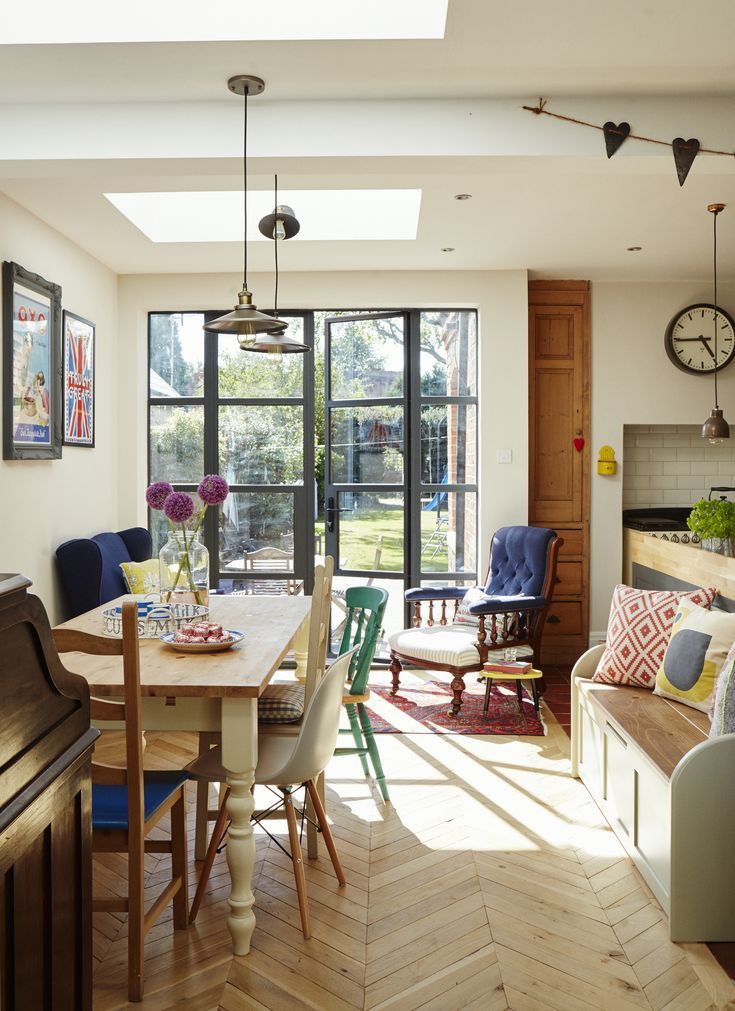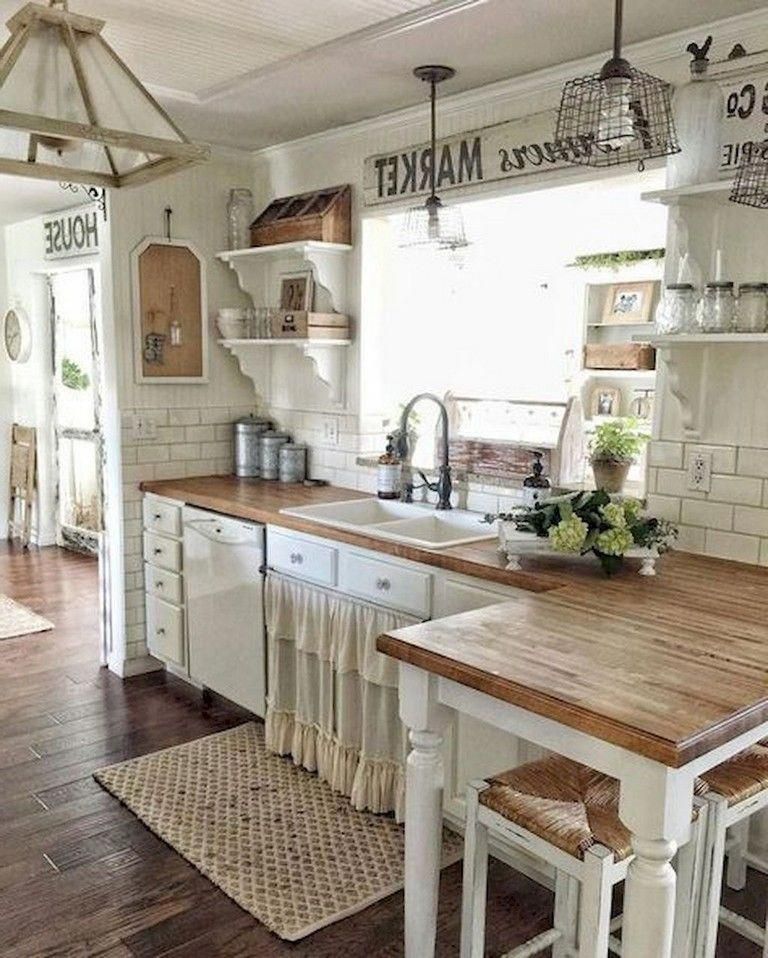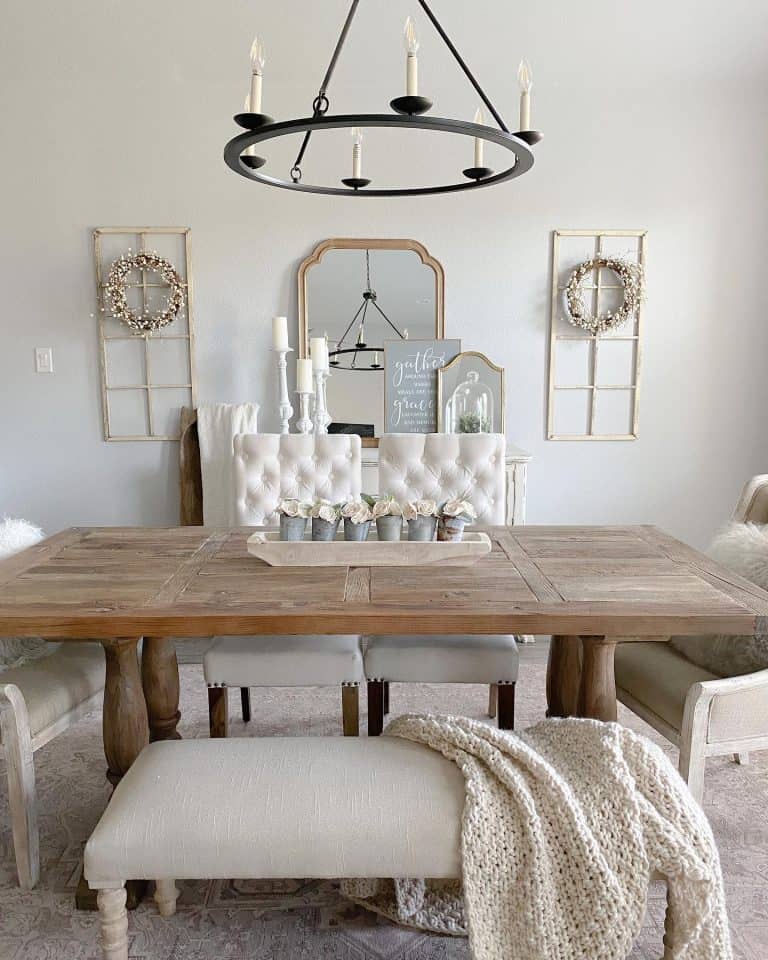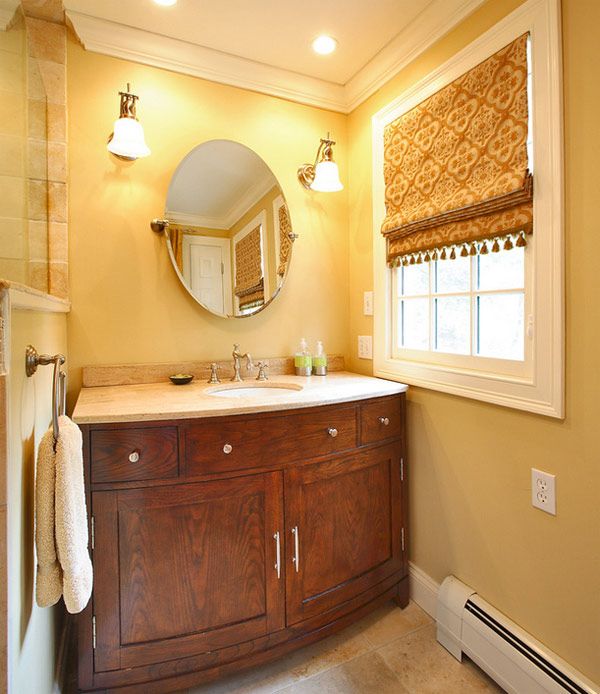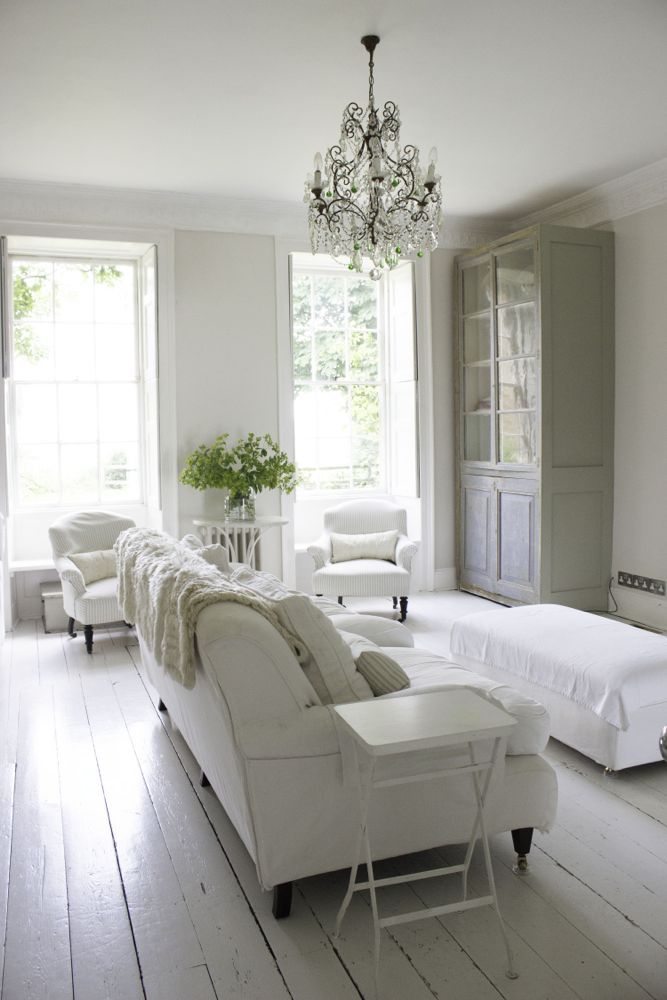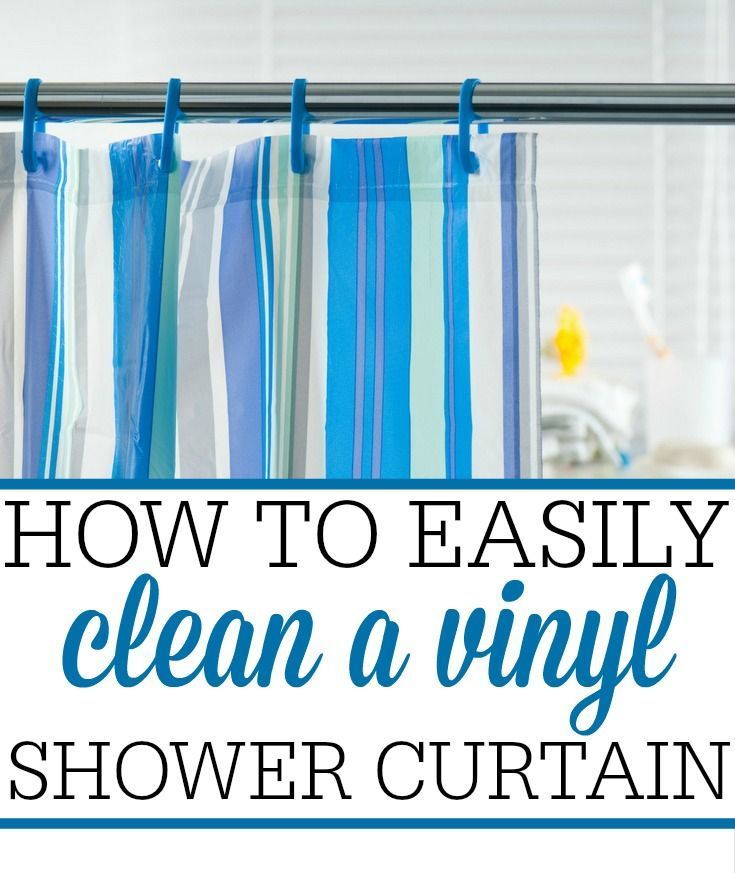Kitchen living room extensions
32 Kitchen extension ideas – to maximise the potential of your space
Looking for beautiful kitchen extension ideas? Our showcase of light and bright kitchen extension ideas will inspire and help you create your perfect scheme, transforming a cramped layout into an inviting modern space for cooking, dining and family time.
One of the most popular building projects for homeowners, the kitchen extension can create a big open-plan living space for cooking, dining and lounging.
A must-have in new properties and one of the top remodelling projects in period homes, the generous open-plan kitchen is now the epicentre for modern living. There are several ways to scale-up space, from combining adjoining rooms or adding a conservatory to building a completely new room or digging out the basement. Be under no illusions, all options require time and money but, once the dust has settled, it's a decision many celebrate.
Do you need kitchen extension ideas and planning advice? READ: Kitchen extensions – how to design, plan and cost your dream space
Kitchen extension ideas
A kitchen extension has the potential to totally transform your home. But it’s a big expense, and one that requires a lot of thought and consideration. As well as boosting your home’s floor space, a cleverly-conceived project also has the potential to increase your home’s resale value – making it a wise investment.
1. Create a thoughtful layout
(Image credit: Studio Varey/Alexandria Hall)
Architects Studio Varey transformed this charming semi-detached North London home with a sleek new kitchen extension. A newly open-plan ground floor houses a modern kitchen /dining space, extending out into the back garden, that takes inspiration from orangery ideas with its large skylight.
'The new space is filled with natural light from both the large skylight positioned over the dining table, as well as the expansive glass doors that allow this family to bring the outside in and maximise the home’s connection to the garden' say the design experts. The kitchen design features composite countertops and a large run of tall cupboards, which have created over 50 per cent more usable storage, a key request for this family home.
2. Form a relationship with the outside
(Image credit: Future PLC/Chris Snook)
The kitchen is the ideal place to add a glass extension with folding doors to open the indoor space to the outdoors. This form of extension is ideal for preventing a small kitchen from feeling enclosed. This Edwardian house features a modern rear extension which allows the kitchen-dining area to seamlessly flow into the beautiful garden beyond.
3. Envision how the space is best used
(Image credit: Future PLC/Colin Poole)
The main objective with this kitchen extension was to create a spacious kitchen with the island and dining table taking centre stage. 'We used Resi , an architecture practice, to secure planning permission,' explains this homeowner. 'We produced several different layouts on graph paper, detailing the dimensions for the space needed – for things like walking between the island and kitchen units. And what might be required for the seating area.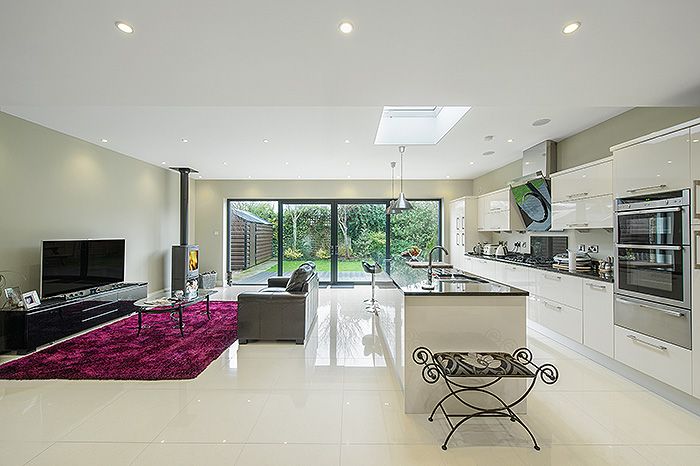 '
'
‘It was a fairly straightforward design using planed structural timber, double-glazed panels and power-coated aluminium capping. In fact, it was probably cheaper than a slate and Velux alternative and allows plenty of light to flood in.’ The combination of a glazed pitch roof and large steel-style windows and doors provide a bright, airy feel to the kitchen.
4. Mix materials
(Image credit: Future PLC/Colin Poole)
Use a mix of materials to get the best from your kitchen extension. Allow a brick extension to extend the space, retaining structure and warmth within the framework. But pair the brick with steel framed doors that offer an airy feel, allowing the outside to integrate with the indoor space. Further use of glass with a roof lantern adds a contemporary edge to the design, that floods the main kitchen area with natural light.
5. Create a multi-purpose space
(Image credit: Future PLC/David Giles)
At the planning stages work with your architect to create a space that can provide the perfect balance for your lifestyle.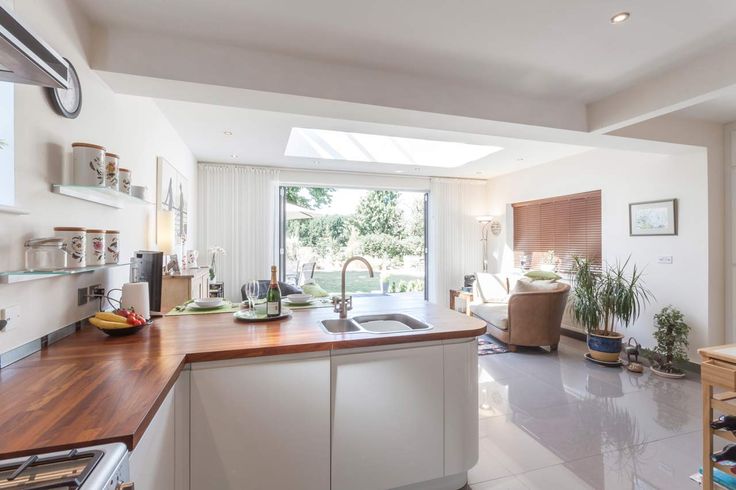 A smart kitchen extension that can seamlessly integrate cooking, dining and socialising is a great way to use the space – especially when working from a small floor plan. Using larger furniture pieces to help create the different zones is an ideal solution, to save on structural divisions
A smart kitchen extension that can seamlessly integrate cooking, dining and socialising is a great way to use the space – especially when working from a small floor plan. Using larger furniture pieces to help create the different zones is an ideal solution, to save on structural divisions
6. Make the walls retract
(Image credit: Future PLC)
Consider an extension that allows a seamless fusion of outside and inside dwellings. Sliding doors, which all but disappear, are the best way to completely open the space up. Making the new configuration a welcome extension of both the kitchen and the garden. Aside from having the freedom to unit the spaces in summer, in winter the glass structure allows maximum light capacity – to keep the space feeling open and airy, ideal in smaller kitchens.
7. Double the size by repurposing a side return
(Image credit: Future PLC/Veronica Rodriguez)
Use redundant space from a side return to create extra space for an open-plan kitchen and dining area. The extra footage will allow adequate room for a more comfortable living arrangement. The extension also opens up the possibility to put in skylights and doors across the back to create a further sense of openness.
The extra footage will allow adequate room for a more comfortable living arrangement. The extension also opens up the possibility to put in skylights and doors across the back to create a further sense of openness.
8. Use glass to balance the light
(Image credit: Future PLC/Polly Eltes)
This period village house is enhanced by a contemporary glass extension and modern interior. Extending out a few metres beyond the boundary wall is enough to completely open the ground floor space. Where the garden is at a higher level to the ground floor the use of glass across the entire rear extension helps to ensure the sunken space isn't dark and enclosed.
9. Adapt the space to fit the new normal
(Image credit: Future PLC)
Our homes have never had to work harder to incorporate our growing needs. Kitchens have always been considered the heart of the home – and in 2021 they are very much so, as they become home offices, restaurants, classrooms and more.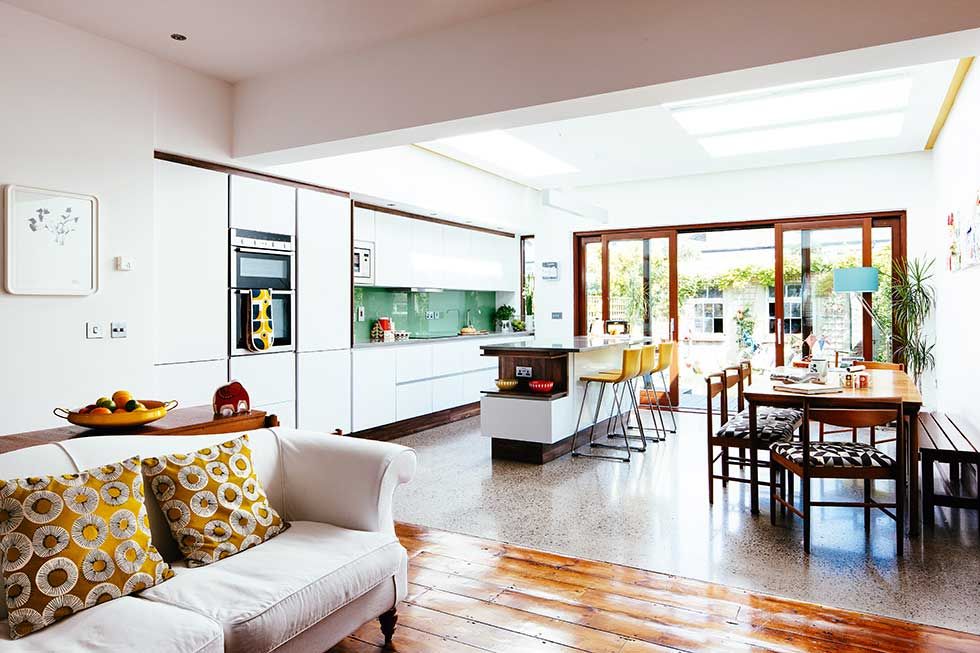 Not to say how we live now will stay, but designers are most definitely sensing this will influence how we use the space in the future. An extension can pave the way for a reconfigured layout that complements your 'new normal' lifestyle.
Not to say how we live now will stay, but designers are most definitely sensing this will influence how we use the space in the future. An extension can pave the way for a reconfigured layout that complements your 'new normal' lifestyle.
10. Use extended glass panels to let the light in
(Image credit: Future PLC/Colin Poole)
Lose a wall by installing glass panels and folding/sliding doors for a space that opens up completely to the garden beyond. This smart extension doesn't go out further, it uses the space vertically to flood the room and incorporate the garden.
Pick and position wall and base units by thinking about the outside space too. Here the honeyed tones cabinetry helps to draw the eye up and out, while the lower cupboards are grounded by a darker hue. All the design aspects work in tandem to open up the space, without having to make a larger footprint for extending. A high traffic throughway will need a hardwearing floor so choose a durable dark-tiled version.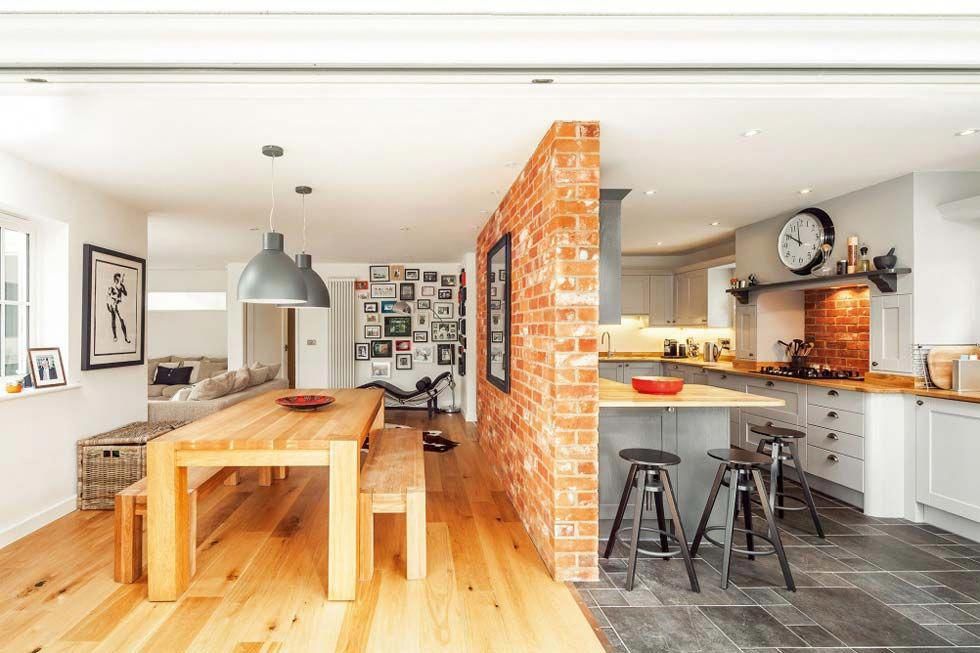
11. Unify the ground floor through thoughtful decor
(Image credit: Future PLC/Polly Eltes)
Extend your kitchen thoughtfully by extending your decor from room to room, so one living space flows seamlessly through to the next. This elegant open-plan kitchen space uses a coordinating colour palette with the sitting room at the front of the house. Along with light fittings and flooring choices that feel at harmony with a living room decor.
12. Put safety first when thinking of the layout
(Image credit: Future PLC/Chris Snook)
Essential if you have small children in the house, the most efficient and safest layout will route traffic away from your oven and hob to ensure kids aren’t likely to get themselves under your feet and into danger when you’re moving hot pans around the room. Make the fridge accessible but don’t put it at the very heart of the room. Try placing it to one side, nearest the entrance to the room, so children can help themselves to drinks without venturing into the cooking space.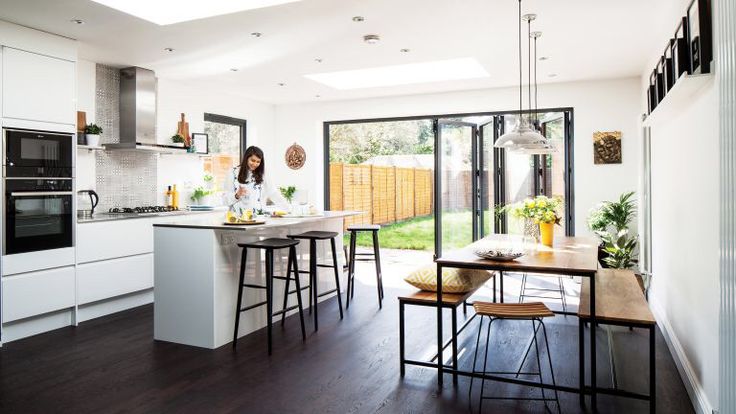
13. Incorporate structural elements
(Image credit: Future PLC)
Instead of trying to hide structural steel beams, turn them into part of the design. In this instance the black patio window frames and black steel beam bring balance and interest to this simple white kitchen.
14. Create a viewing room
(Image credit: Future PLC/Brent Darby)
If you have extended into your garden space, make the most of lovely views. Let the windows be the star of your decorating scheme and wherever possible place furniture where it can oversee your outdoor space.
Keep a decorating scheme pared back, and simple so the view is always foremost. Go for matching neutrals across the board with simple decorative touches, a reclaimed table and eclectic chairs. Use glass wall lights for added character at night time.
15. Be brave with clashing colour
(Image credit: Future PLC/Lizzie Orme)
Your newly reconfigured kitchen is the ideal place to use colour. But be sure to thinking about the long-life factor. Love pink, the colour of the moment but scared it will date quickly? Why not experiment with a small section of the wall above the tiles? After all, it's not a huge deal if you decide to change it at a later date. The key is using a clever combination of materials to create a colour clash. Dilute block colour in a kitchen by separating bold shades with patterned tiles, different shades on cabinets and through accessories.
But be sure to thinking about the long-life factor. Love pink, the colour of the moment but scared it will date quickly? Why not experiment with a small section of the wall above the tiles? After all, it's not a huge deal if you decide to change it at a later date. The key is using a clever combination of materials to create a colour clash. Dilute block colour in a kitchen by separating bold shades with patterned tiles, different shades on cabinets and through accessories.
16. Make storage attractive and accessible
(Image credit: Future PLC/Colin Poole)
Don't want to waste time rummaging for things in the backs of cupboards? Create an open shelving system, like the one in this U-shaped kitchen idea, and you'll have utensils, cookery books and other items that you frequently use to hand when you need them.
17. Welcome warmth with brick
(Image credit: Future PLC/David Parmiter)
If you've built a new wall or relocated one as part of your extension leaving the bricks exposed on the inside will give your kitchen character and warmth. Reclaimed bricks look best as the irregularity of colour and texture will pick up other tones in your cabinetry and flooring.
Reclaimed bricks look best as the irregularity of colour and texture will pick up other tones in your cabinetry and flooring.
18. Extend out with a side return
(Image credit: Future PLC/David Giles)
Extending out to the side is a good option if you live in a semi-detached or detached home, as it doesn’t mean using garden space. You may lose side access to your garden though, and planning permission can be trickier as it will be determined by how close you are to you neighbour’s boundary.
For period terraced homes the path or back garden to the side of a kitchen at the rear, called the side return can be extended into to create a kitchen that runs the full width of the house. Remember, though, to consider how light will then reach the rooms the new space will extend over. You can also combine rear and side extensions for a stunning wrap-around kitchen.
19. Consolidate storage
(Image credit: Future PLC/Richard Gadsby)
Plan your kitchen extension storage with care. If you have the space, it pays to keep cupboards to a specified area rather than have them dotted all around.
If you have the space, it pays to keep cupboards to a specified area rather than have them dotted all around.
In this impressive extension, base and wall units have been banked together on a single wall and long, full-width island. This not only keeps everything close to hand at the busy, business end of the space, but allows you to co-ordinate your colour scheme - in this case, a dark-grey matt paint finish.
Want more kitchen ideas? READ: Kitchen cabinets – what to look for when buying your units
20. Use a peninsula as a divider
(Image credit: Future PLC/James French)
Define the different functions of your extension with well placed units. If you have extended out into your garden from the back wall of your house, the line of the old wall will quite often make a natural dividing point for the new extension.
Here, a rigid steel joist and window mark the spot. The worktop below houses a sink, a couple of cupboards and a mini breakfast bar and divides the working kitchen from the dining and sitting area overlooking the garden.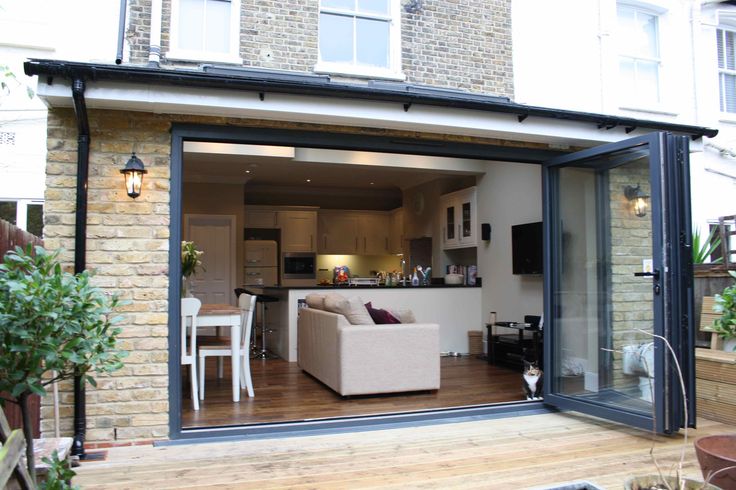
21. Consider glazed doors
(Image credit: Future PLC/James Merrell)
In larger extensions with high ceilings you may feel you need more than furniture to divide up an open-plan space. These full-height sliding glazed doors are a revelation, adding smart, defined verticals to the design and marking a change of function between kitchen and living areas without screening anything from view.
Low-hanging pendants and fabulously tall storage emphasise the height of this space, with cornflower blue paintwork and slate wall tiles uniting the decorative elements.
22. Build in, build out
(Image credit: Future PLC/Amanda Turner)
Enjoy the freedom to fit out a room from scratch. Plan your new extension carefully and in a perfect world you will end up with a room that balances practicality and beauty.
Every appliance and every ounce of storage will occupy its ideal spot. This kitchen uses a false wall to house built-in ovens, open shelving and upright and overhead cupboards, while the hob, sink, wine cooler and supersized drawers have been incorporated into a stand-alone island.
Looking for more kitchen decor inspiration? READ: Kitchen lighting – everything you need to know
23. Unite a multifunctional space with materials
(Image credit: Future PLC/Alistair Nicholls)
Use a single material throughout an extended space to keep the feel orderly, contained and open. This extension features a country kitchen with breakfast bar, a seating area and separate dining space.
Decoratively, this could be a messy arrangement, but the use of wood throughout brings its own settled order. From the fitted shelves and larder unit at the back of the room, through to the impressive breakfast bar at the centre and out to the low coffee table, farmhouse dining table and mismatched chairs inspired by shabby chic decorating ideas, the warm wood tones unite the scheme. Pops of vibrant colour on soft furnishings and ceramics to add to the fun.
24. Seek out and follow the light
(Image credit: Future PLC/Paul Raeside)
In a kitchen extension, position a dining table where the maximum light falls.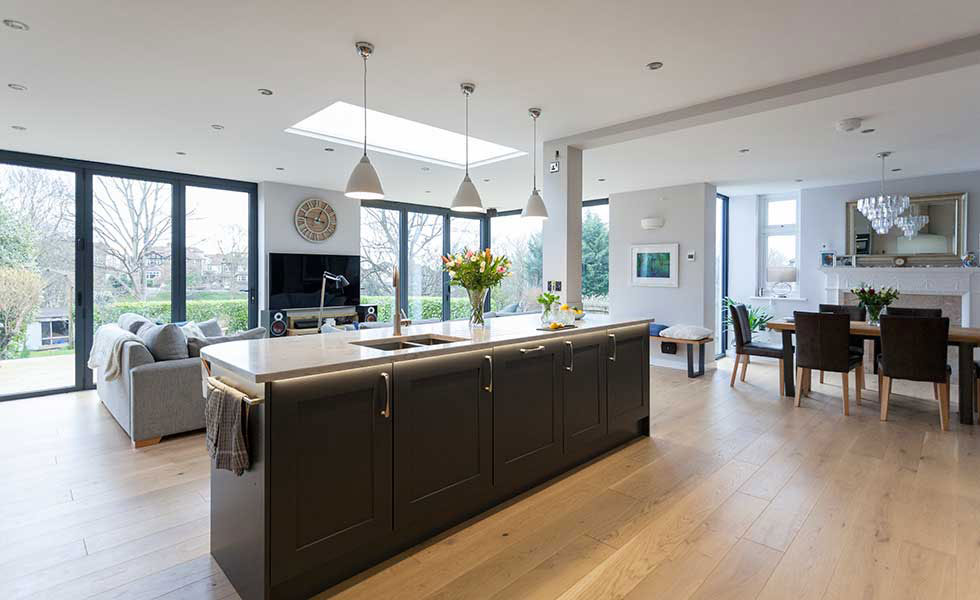 In this space, which lacks conventional windows, roof lights bring drama and atmosphere to the table. An adjustable, wall-hung pivot light adds a modern touch.
In this space, which lacks conventional windows, roof lights bring drama and atmosphere to the table. An adjustable, wall-hung pivot light adds a modern touch.
Look for furniture that fits the space you have as exactly as possible. This table is the width of two place settings and no more, allows room for chairs to move in and out and is the perfect length to make full use of the room's dimensions.
25. Unify with a theme
(Image credit: Future PLC/Colin Poole)
Integrate your extended space by using a single decorating scheme throughout. Pick calm, soothing and co-ordinating colours that will lift and lighten the feel. For a fresh, coastal vibe, go for a powder blue backdrop. Match woodwork and cabinetry with cream Shaker-style doors for a sense of continuity - in this space, built-in cupboard doors are painted to match the units. In a similar way, use oak for worktops, tabletops and seats and blue striped fabric for seat pads and kitchen linen.
26.
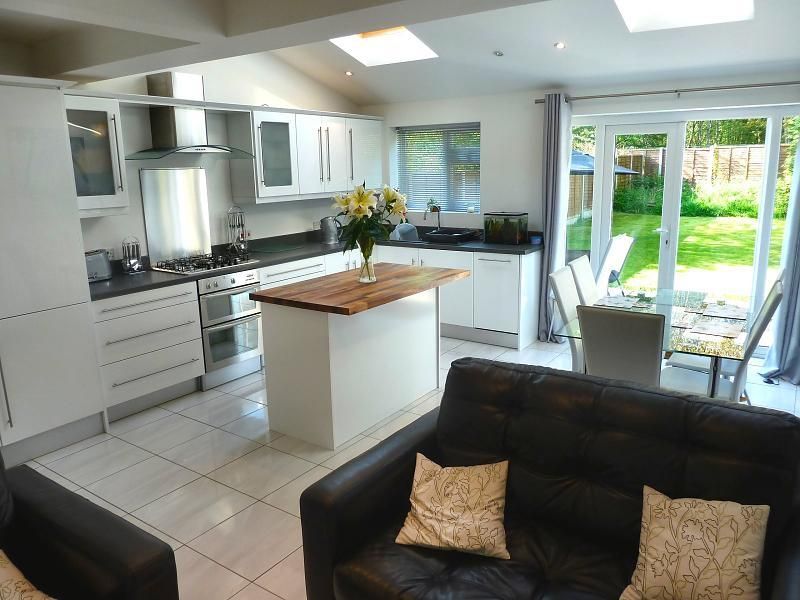 Let architecture lead function
Let architecture lead function(Image credit: Future PLC/David Merewether)
Consider the features of a building when designing your kitchen space, whether you are extending into a side return or looking for bungalow extension ideas.
Set aside the space under a glazed roof for dining - this space also has a square bay, perfect for enjoying garden views - and keep the original space for more functional tasks, such as cooking and food preparation.
Choose a cream palette to link the spaces together and warm up with oak worktops and a matching butcher's block.
27. Adopt multifunction living
(Image credit: Future PLC/Rob Sanderson)
Plan well and a large kitchen extension has all the makings of the perfect open-plan living space. Create distinct and separate zones for cooking, dining and relaxing, but ensure continuity with a neutral shade throughout.
Use a central island to divide the room and make cooking social by adding a breakfast bar. Position the dining table adjacent to patio doors to get the best view and a comfortable armchair in one corner for enjoying the new-found light.
Position the dining table adjacent to patio doors to get the best view and a comfortable armchair in one corner for enjoying the new-found light.
Need some kitchen inspiration and advice? READ: Kitchen worktops – everything you need to know
28. Temper the new by referencing the old
(Image credit: Future PLC/David Still)
When designing and decorating a new extension, always keep the style and period of your home in mind. Pick up on any period architectural features and incorporate design elements of any adjacent rooms into your new space.
In a large, multifunctional area emphasise continuity by using freestanding cupboards or sideboards as feature cabinetry. Choose finishes that reflect the mix of old and new, such as the mahogany and Shaker-style designs used here.
(Image credit: Future PLC/Nicholas Yarsley)
Whatever type of extension you choose, be sure to reflect that design in your kitchen scheme.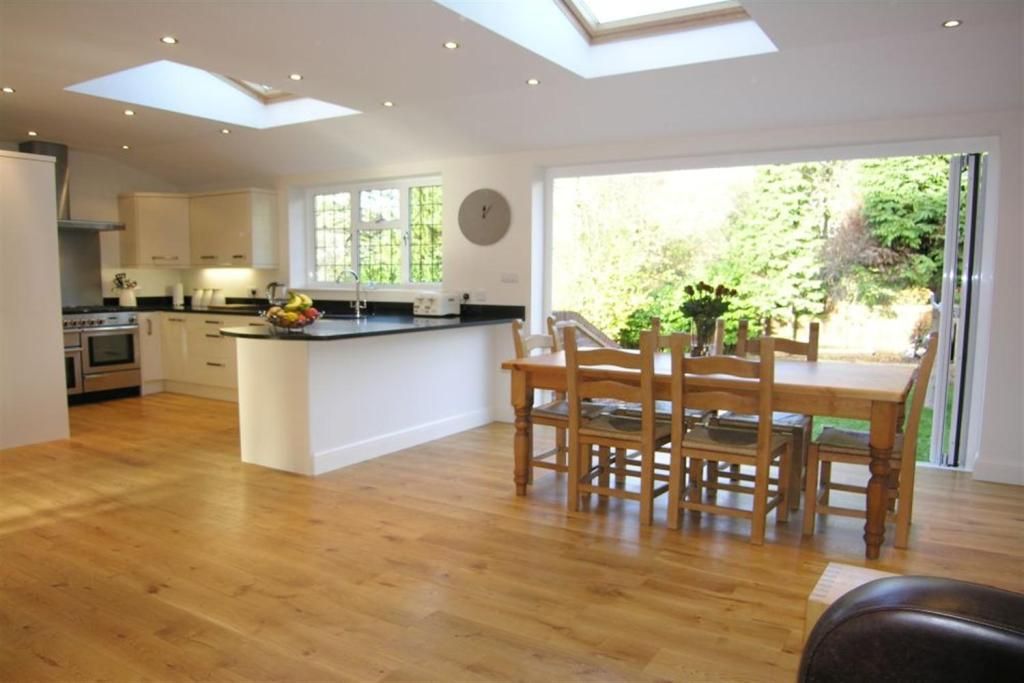 Let the architectural style and shape inspire your choice and positioning of cabinetry and furniture.
Let the architectural style and shape inspire your choice and positioning of cabinetry and furniture.
In this home an impressive seven-metre-long workstation mirrors the run of roofline windows above, creating a balanced design that is also a practical solution to providing naturally lit worktops.
Enhance the visual impact with a strong matt colour and the storage potential by including cupboards.
30. Pick simple but strong colour schemes
(Image credit: Future PLC/Fraser Marr)
The modern extension will increase the light levels in a property, so be adventurous with colour in your new kitchen. Working against a white or neutral backdrop, make a strong statement with a black gloss central island and black modern stools that create crisp, clean-lined silhouettes.
Use gunmetal-finish patio door frames to tie in with stainless-steel appliances. Complement and uplift the scheme with a bright yellow splashback and matching pendant lights that draw the eye upward to impressive roof lights.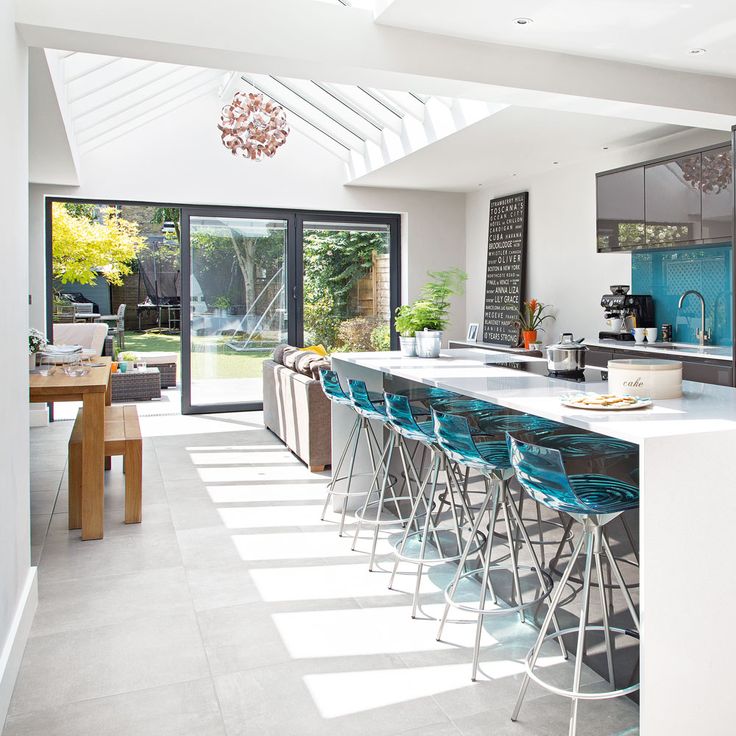 This will simplify and streamline the scheme, particularly in a smaller extension.
This will simplify and streamline the scheme, particularly in a smaller extension.
Love these kitchen extension ideas? READ: How to build an extension – everything you need to know
31. Blur the boundaries
(Image credit: Future PLC/Richard Gadsby)
Use an extension to continue your kitchen space outside. Choose floor tiles that allow a continuous flow from kitchen to patio, giving the illusion of one large room.
Use the white of your cabinets and kitchen walls on external brickwork, masonry and planters. Create an outdoor cooking area that has all the features of a kitchen rather than a barbecue, including a worktop positioned to continue the run of the kitchen version inside.
32. Colour code kitchen zones
(Image credit: Future PLC/David Giles)
Make large, open-plan spaces work by using colour to define different functions. Try white, handleless cabinetry for a practical, easy-to-maintain cooking and food preparation area.
Introduce a contrast shade on a breakfast bar island to signpost the change of function, but keep the worktop white to indicate that this is a dual-function surface. For dining, go unfinished wood - in keeping with its proximity to the patio, this table and chairs could be mistaken for garden furniture.
Unify the whole with timber flooring, a wooden sideboard and a row of wooden bar stools.
How much does a kitchen extension cost?
Keep a close eye on your budget. Start by allocating a project fund for your architect to work with. If you let them know your key goals – a bespoke kitchen, for example – they’ll be able to tweak other aspects of
the scheme to help bring it all in on budget. Set aside between £1,100 and £1,300 sq m for small, single-storey schemes or £1,300-£1,500 sq m for two-storey extensions. Allow at least £2,500 sq m for large-scale
projects or those featuring high-spec materials.
We've all seen Grand Designs when the budget suddenly spirals out of control.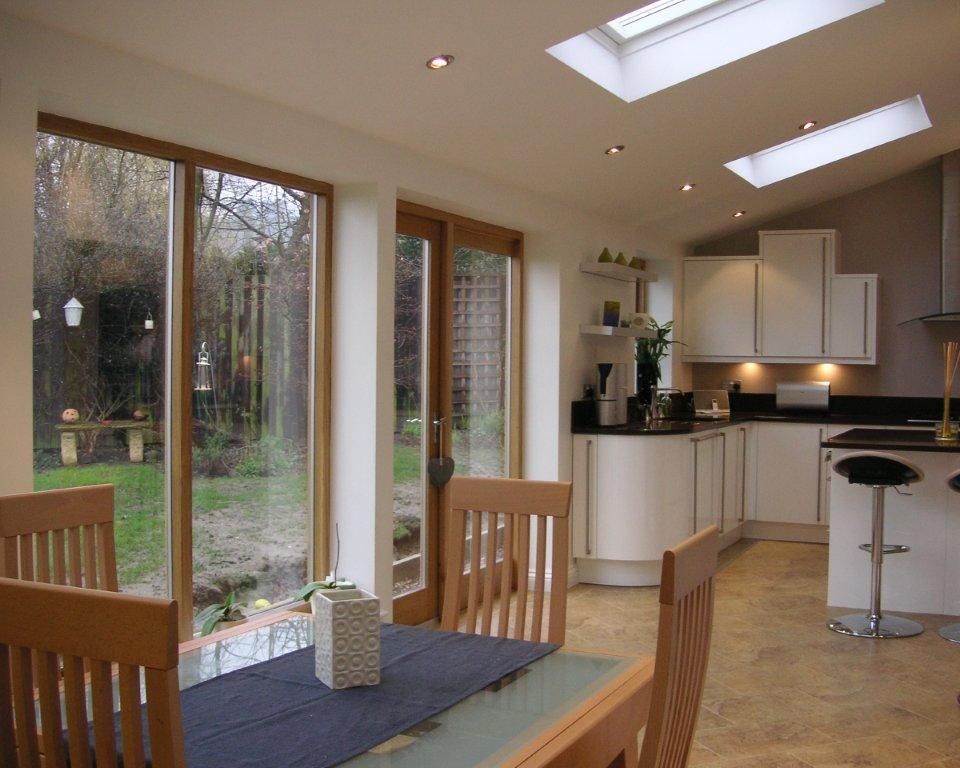 It’s a good idea to ring-fence a 10 per cent contingency fund, just in case. If you budget properly and use trusted tradespeople you won't need to access the extra money, but better to be safe than sorry. Plus it can go towards furnishing the new space.
It’s a good idea to ring-fence a 10 per cent contingency fund, just in case. If you budget properly and use trusted tradespeople you won't need to access the extra money, but better to be safe than sorry. Plus it can go towards furnishing the new space.
Do I need planning permission for a kitchen extension?
While many extension schemes can be achieved under permitted development rights, anything that’s pushing the boundaries in terms of design is likely to require formal consent from your local authority. Likewise, if you live in a conservation area or area of outstanding natural beauty, you will need planning permission to go ahead.
Working with an architect or planning consultant can increase your chances of success at this stage as they will be aware of local planning policy. It can also help to find similar extensions on your street, as these can serve as a precedent for your project.
A single-storey rear extension is often the most planning permission-friendly extension project, and can often be achieved under permitted development.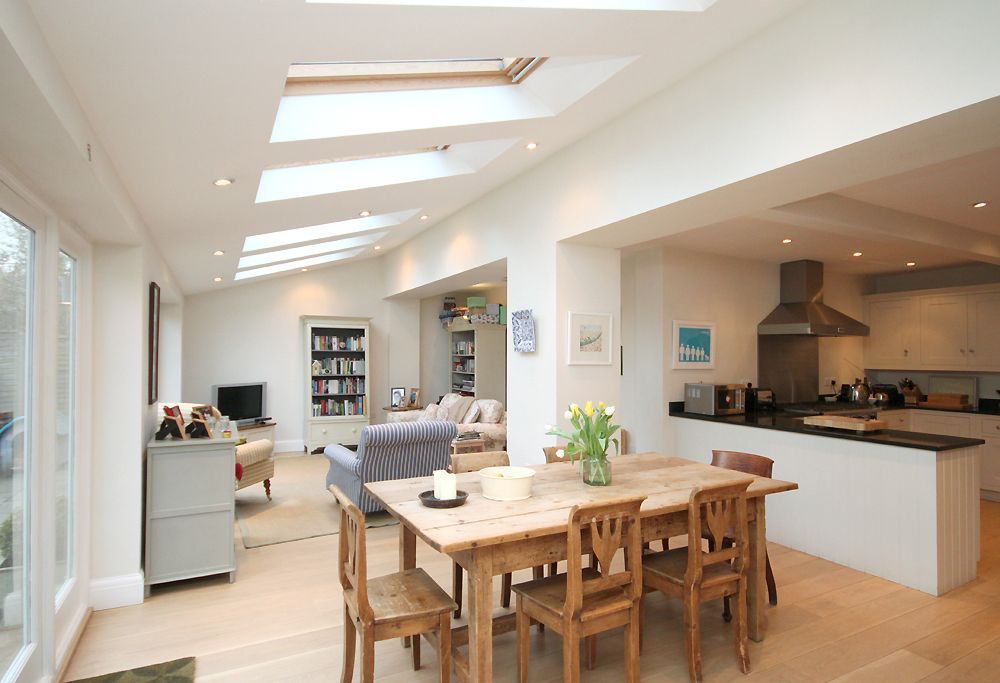 Keep in mind the balance between house and garden, as swallowing up too much garden may be detrimental to the properties value. A simple side extension is also planner-friendly and can widen a narrow kitchen without stealing precious outdoor space. Side-returns are a common choice for terraced properties, which often have a half-width kitchen tacked onto the rear.
Keep in mind the balance between house and garden, as swallowing up too much garden may be detrimental to the properties value. A simple side extension is also planner-friendly and can widen a narrow kitchen without stealing precious outdoor space. Side-returns are a common choice for terraced properties, which often have a half-width kitchen tacked onto the rear.
Building a basement kitchen is significantly more expensive than extending outwards. Converting an existing basement will be cheaper. This type of extension is popular where outdoor space is often limited, but it also works if you want to preserve the proportions of a building or retain all of the garden. It’s wise to use a specialist basement firm (try The British Structural Waterproofing Association, thebswa.plus.com, for accredited contractors).
Related: Kitchen lighting ideas – to deliver the right brightness levels as and where you need it
Will you be using these kitchen extension ideas?
Additional words, expert advice to answer key questions, by Rebecca Foster
15 small kitchen extension ideas to help you add space
Real Homes is supported by its audience.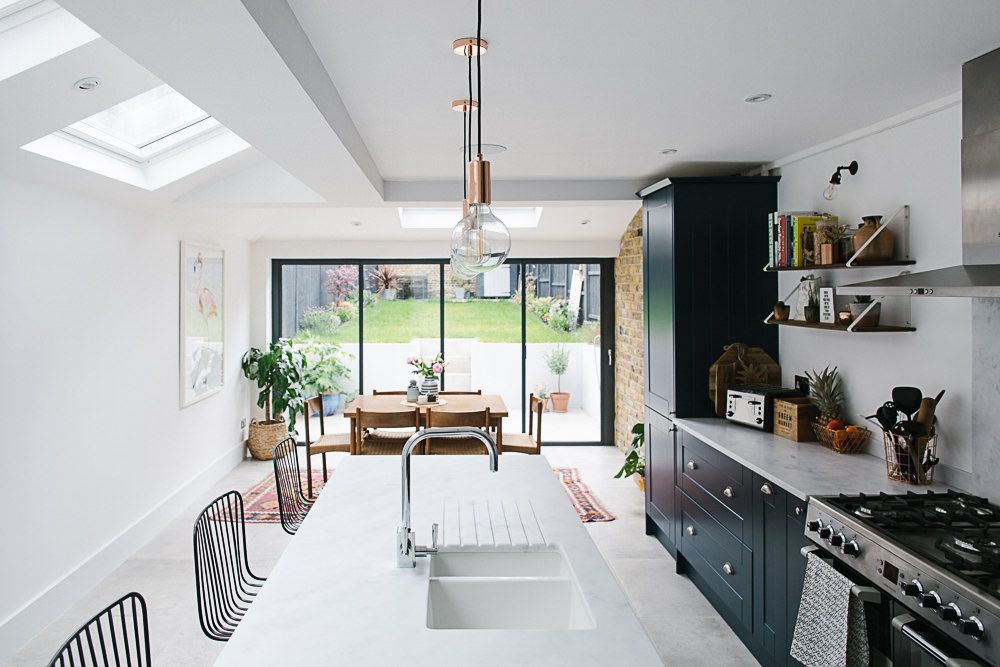 When you purchase through links on our site, we may earn an affiliate commission. Here’s why you can trust us.
When you purchase through links on our site, we may earn an affiliate commission. Here’s why you can trust us.
(Image credit: deVOL)
Join our newsletter
Thank you for signing up to Realhomes. You will receive a verification email shortly.
There was a problem. Please refresh the page and try again.
By submitting your information you agree to the Terms & Conditions and Privacy Policy and are aged 16 or over.Looking for gorgeous but achievable small kitchen extension ideas? Well good, you are in the right place because we are all about gorgeous but achievable. We have brought together all our fave small extensions just to prove what you can do even when you don't have a ton of space.
A kitchen extension is a the top of most homeowners' wish lists. They add space, light and value to your home, plus they are the perfect way to create that open-plan space that's become such an essential to modern living. And don't go thinking just because your kitchen is on the smaller side, or you don't have acres of land to expand into you can't add an extension.
'There are three main types of kitchen extension which have different suitabilities to different properties.' explains Robert Wood, Managing Director Simply Construction Group. 'A rear extension extends backward into garden space, a side-return uses the dead space down the side of the property, and a wrap -around extension combines these together connecting in the corner. A side return is most likely the best option for a small kitchen extension, as this adds width to your kitchen, making it seem a lot more spacious. A rear extension is less popular if you are already lacking garden space, but they suit almost all properties.'
Whether you want to add a side return to create a more open plan feel, or looking to create a glass box extension to bring in lots of lovely light, you can create your dream space whatever the size. Just check out these spaces, none of which are huge, all of which are beautiful...
- Find more kitchen extension ideas and advice in our ultimate guide
1.
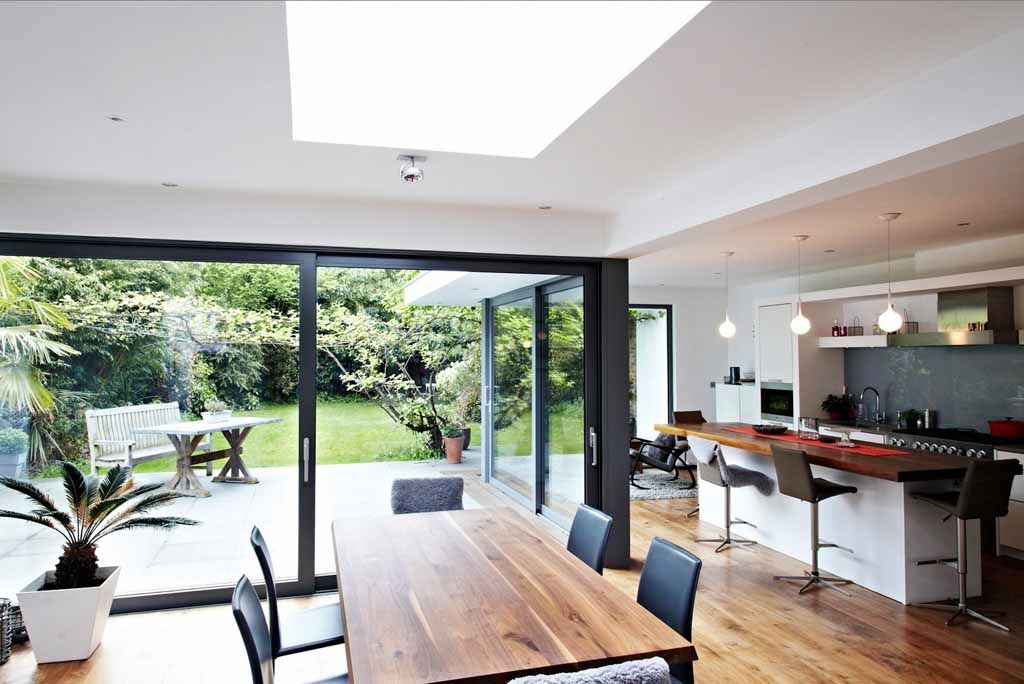 Decide where you will place your kitchen extension
Decide where you will place your kitchen extension (Image credit: deVOL)
The key to creating a kitchen extension of any size is plenty of planning. So the first step is to plan where your extension will actually go. In a smaller space you might be limited to your options, but don't let that put you off something like a side return (we will cover those here) could be all the space you need to expand your kitchen.
If you have enough space in the garden you could extend to the rear to your property – adding a small extension that brings in plenty of light can make a huge difference to your existing kitchen.
A small conservatory could be an option too, either at the back of your kitchen or as a lean-to at the side. We promise they can look chicer than you think and can be a more affordable choice too.
'Side return extensions are still the best design for small kitchen extensions. However, if you do not have space available at the side of your home, then you can always extend outwards into your garden.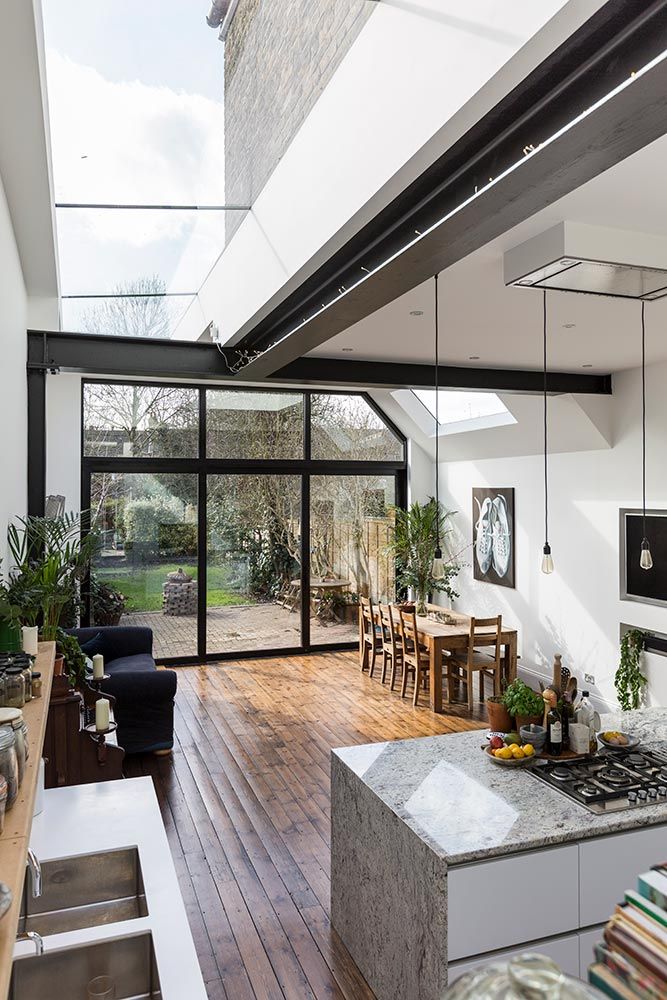 ' explains Robert Wood.
' explains Robert Wood.
'Glass extensions have a beautiful look to them and let lots of light into a small extension. The downside is that they lack good insulation properties so may feel cold in winter and too warm in summer. The most practical extensions would be block and brick-based, however why not opt for skylights on the roof and or fixed glazed paneling to flood the area with light. There are also plenty of great door options for extensions that can help make a small extension feel bigger, I.e. Bi-folding or sliding doors.'
A good architect can advise you on all your options for your exact space, and tell what's worth doing and want isn't. Check out our guide to how to work with an architect for all you need to know.
(Image credit: Kasia Fiszer)
You'll also want to be constantly thinking of the layout of your actual kitchen while planning your extension. If you have your heart set on a certain layout this could dictate the whole design.
'Assuming you have no space to accommodate an island unit (which typically needs 600mm for the worktop area + 1100mm gap to the island unit + 600/900mm for the island unit + maybe 800mm from the edge of the island unit to the wall opposite) then you need to think of shapes. ' explains George Omalianakis from GOAStudio London Residential Architecture Limited .
' explains George Omalianakis from GOAStudio London Residential Architecture Limited .
We'll give you a quick low down of your potential options but check out our guide to how to plan a kitchen for loads more help planning your kitchen layout.
- U-shaped kitchen layouts: U-shaped kitchens work so well in open-plan spaces, especially if you can't squeeze in an island because you can create a similar effect by using one side of your U-shape as a breakfast bar. They are also a good shape for small spaces too as they max out storage and work surface space. 'Find a long blank wall to form the spine of this shape, orientate the open part towards the rest of the room, and start imagining where the cooker goes, where the sink goes and where the fridge goes. This is always a good starting point. Once you have anchored these three things in the layout the rest of your fittings and appliances will naturally gravitate to the right place.' explains George.
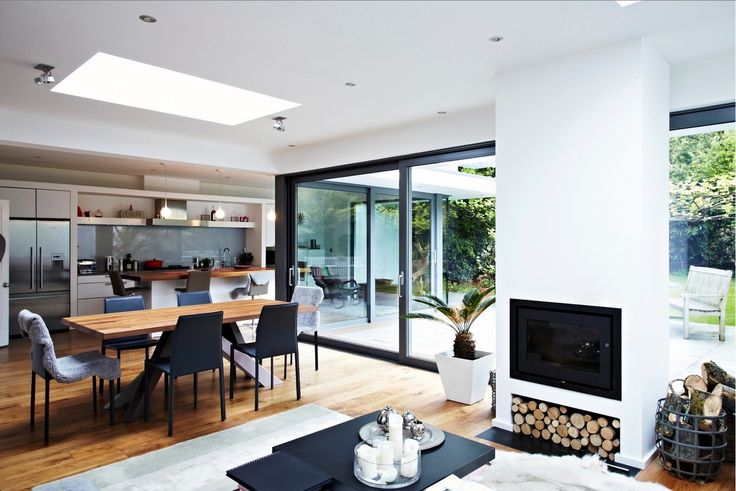
- L-shaped kitchen layouts: another great choice for creating that open plan feel in your small kitchen extension. Plus this shape lends itself well to adding an island or a dining table in the center of the space.'Look to create a sense of openness and an informal connection with the dining area. This layout is not as efficient as the U-shape but done property it will offer the perfect balance between defined boundaries between the kitchen / dining areas and an open plan layout.' advises George.
- Galley kitchen layouts: a less obvious choice if you are adding a kitchen extension, but if you are planning on extended backward rather than outwards this would be the most efficient layout in a narrow space. 'Accessorize a galley kitchen with a skylight along the middle between the cabinets. Introduce full height French doors and full height glazed side panels to the garden. Allow min. 1100mm between the two rows of cabinet units and invest in lots of high level cupboard space.
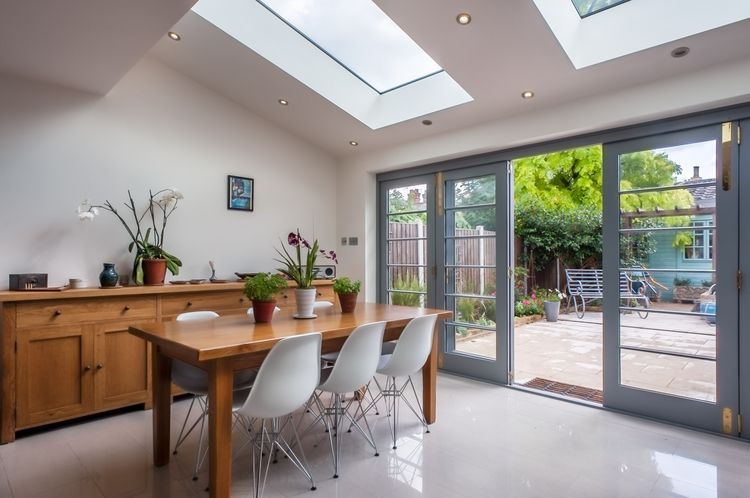 '
'
3. Extend your space with a side return
(Image credit: Fiona Walker-Arnott)
Side return extensions work so well in small space, because they aren't huge but can turn your current kitchen into that open plan space you have been dreaming of. They the most popular option with terraced houses, where you might find a small outdoor space down the side of your house. Filling this unused space means you can expand your kitchen, plus you won't be eating into any of your garden space either.
Oh, and if you go with a design that has plenty of roof lights, you can bring in so much more natural light to your kitchen. This is only going to add to that open, airy feel everyone wants to achieve.
Just bear in mind that planning permission for side returns can be a bit tricker if you building out close to neighbor's houses.
- For more side return extension ideas check out our guide.
4. Add a glass box extension to bring in light
(Image credit: Malcolm Menzies)
Glass box extensions are exactly what they sound like.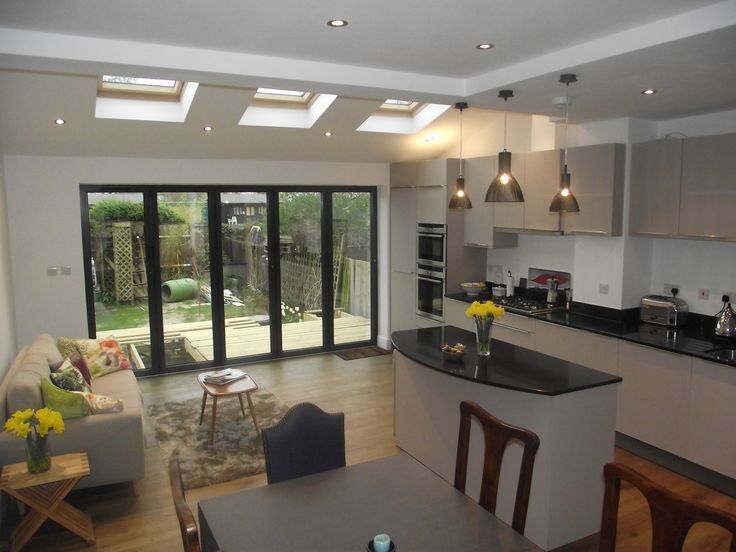 A glass box stuck on your kitchen – and they can look so gorgeous, and obviously bring in a ton of light. Their striking designs are best suited to a contemporary kitchen style, but would suit any style of house, period or modern. They look particularly chic on older buildings to contrast materials.
A glass box stuck on your kitchen – and they can look so gorgeous, and obviously bring in a ton of light. Their striking designs are best suited to a contemporary kitchen style, but would suit any style of house, period or modern. They look particularly chic on older buildings to contrast materials.
You can add a glass box extension as a side return like the one you see here, or you can extend out of the back of your space. But you will have to just make sure you double-check your building regulations because there are limits to how much glass is allowed in one single structure.
- Find out more about adding a glass box extension.
5. Add a small lean-to conservatory
(Image credit: deVOL)
If you are after a slightly cheaper option that will still add space and light to your kitchen, why not add a small lean-to conservatory? Before you go thinking they are best suited by more traditional style homes, just check out this design – modern, chic and totally achievable if you have a small space.
Conservatories that are connected to a kitchen lend themselves to becoming an open plan, dining space or a laid back living room area. Or you could turn the space into your kitchen with a row of cabinetry along one wall and a small island in the middle.
6. Use a roof lantern to zone a space
(Image credit: Fiona Walker-Arnott)
You want a kitchen extension to be bringing in as much light as possible, especially in your space is small, as this is only going to help your room feel more spacious. A roof lantern is an ideal addition to a small flat roof extension as it will bring in light no matter what why your property faces.
Plus they look beautiful and add such a focal point to your space – we especially love when they are situated above a dining table, as seen here, or a kitchen island. You can hang pendant lighting from space too, to make it even more of a feature.
For a more stylish, contemporary look, pick a minimal design that has slim framed that won't block any light.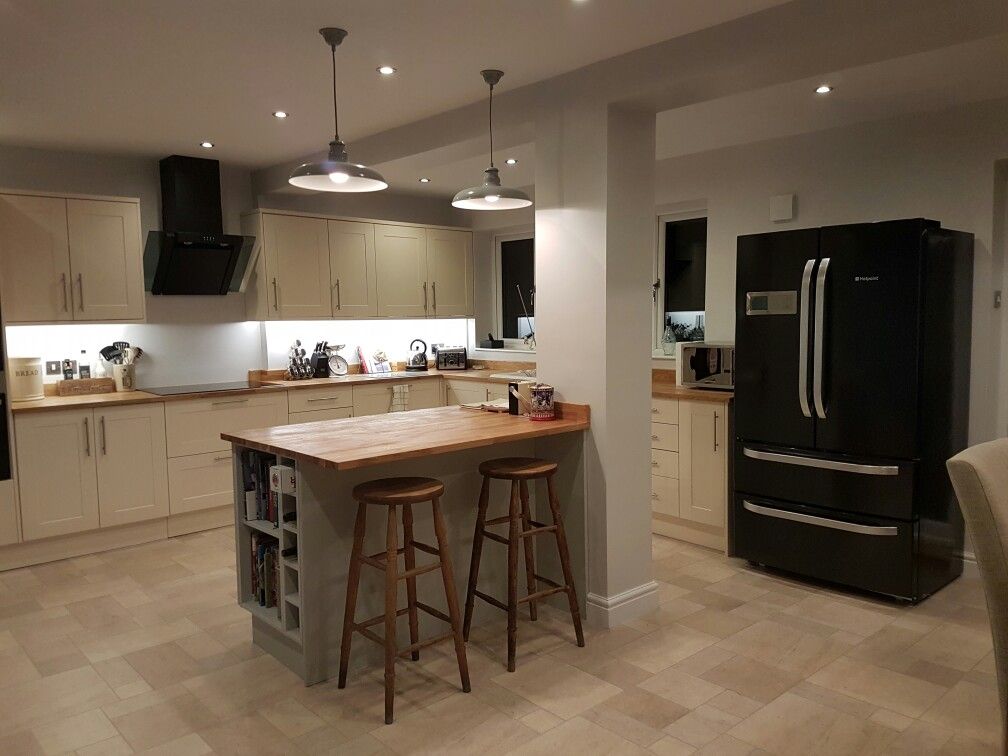 If you are adding doors to your extension, think about how it will look with those and pick designs that are going to complement one another.
If you are adding doors to your extension, think about how it will look with those and pick designs that are going to complement one another.
7. Or open an extension up with roof lights
(Image credit: Katie Lee)
And if you are adding a side return extension or if you want to add more natural light into your original kitchen space, roof lights will always flood a room with natural light. Plus they are guaranteed to make the smallest of kitchen extensions feel bigger and are great for highlighting certain aspects of your kitchen like an island or a dining space.
(Image credit: Chris Snook )
You might not have miles of space to expand out, but if you have the room to go up, do so. Going for a pitched roof rather than a flat one, is only going to make your space feel bigger.
Just carefully consider where your roof lights are going to go, if you want to add any. Placing them on both sides is sure to bring in plenty of light, but it might be too much, especially if your space is south-facing.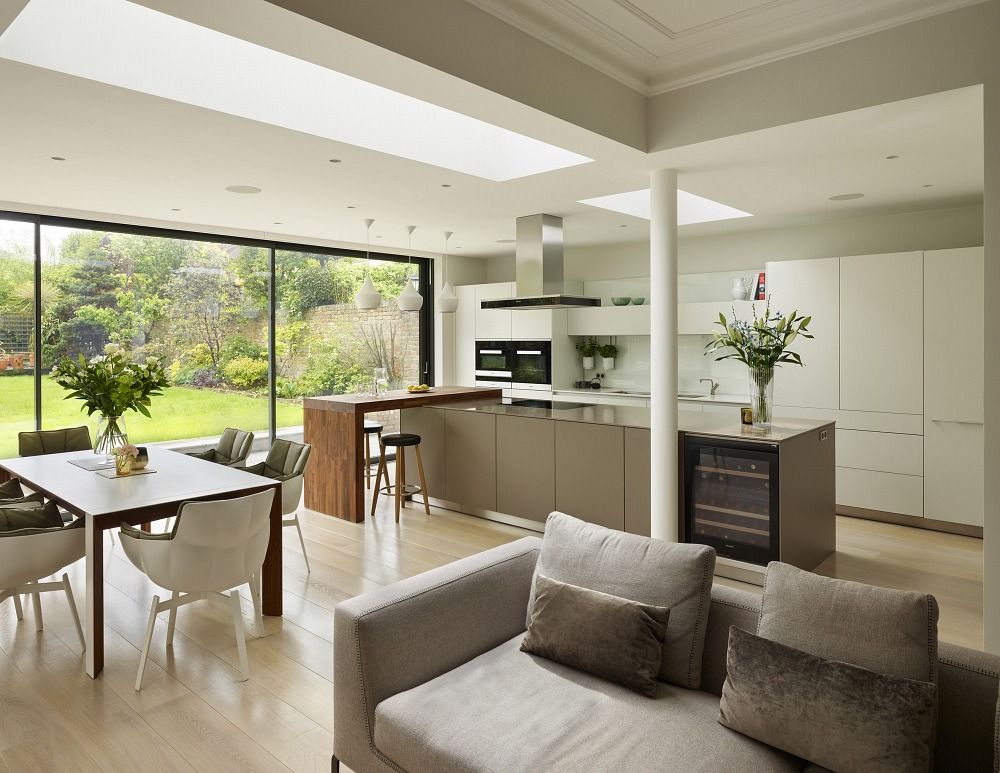 We'd recommend picking one side to add your windows so it doesn't turn into a greenhouse when the sun is out.
We'd recommend picking one side to add your windows so it doesn't turn into a greenhouse when the sun is out.
You could make it a feature too, like in this kitchen extension, the wooden beams give this space modern cabin vibes and warm up the monochrome kitchen. A
9. Connect with the outdoors
(Image credit: Polly Eltes)
Blending your kitchen extension with your outdoor space is an easy way to make your space feel bigger. Choose minimalist bi-fold doors and flooring that's suitable for both the kitchen and the patio or flooring that's similar in tone, to create a seamless flow between both spaces.
It's so lovely in the warmer months to keep the doors open, and using the outdoor almost like an extra dining room or living room. Plus in the winter you still get plenty of light flowing through the space and your can position your furniture so that it still oversees the garden.
10. Add Crittall doors to your kitchen extension
(Image credit: Jemma Watts)
Who hasn't got Crittall-style doors on their lust list? They make a gorgeous addition to a small kitchen extension, bring in a cool industrial vibe that everyone wants right now. You can create different looks too, depending on the size and shape of your design – horizontal rectangles will create a more retro feel, whereas smaller squares are more traditional.
You can create different looks too, depending on the size and shape of your design – horizontal rectangles will create a more retro feel, whereas smaller squares are more traditional.
The metal framing isn't too bulky so you'll still get plenty of light coming in and they can frame your outside space beautifully. If you have windows on the same wall as your Crittal doors, we would recommend going for a similar design to complete the look.
- Have a read through our guide to metal doors and windows for more info.
11. Open up a galley kitchen
(Image credit: Chris Snook)
Galley kitchens can be tricky spaces, but if you want to extend there are a few ways to do so depending on your surrounding space. Expanding out the side is the most obvious option and into any dead space you might have in your garden.
But if that isn't an option for you, you could also add space to the end of your galley kitchen and add doors and skylights to create a lovely, light-filled dining area.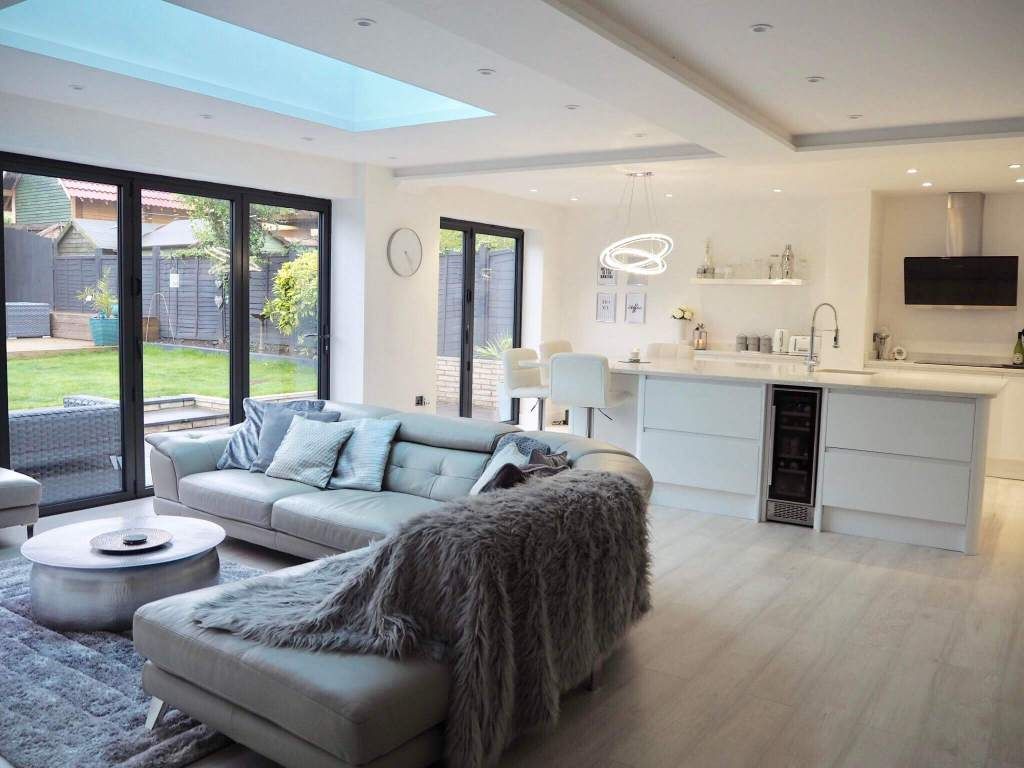 This will give the space more of an open plan feel despite the narrow dimensions.
This will give the space more of an open plan feel despite the narrow dimensions.
'For most kitchen extensions, you will refit your kitchen to fit the new space. However, if you want to keep your old kitchen space and extend into your garden to create a new living space, you can easily do this by keeping an open-plan layout and combining it with a living and/or dining area.' explains Robert Wood Managing Director Simply Construction Group.
'Instead of sectioning off your extension, keep it light and airy by having bright skylights in your roof that light up both your kitchen and living area, to blend them together effectively. Alternatively, opt for a roof lantern to really brighten up the new extension.'
12. Make a feature of architectural details
(Image credit: Katie Lee)
Supporting beams, that often come with adding kitchen extensions, can be something you feel like you have to awkwardly work around and disguise. But why not make it a feature of your space instead? Rather than blur them into the walls make them a feature of your space.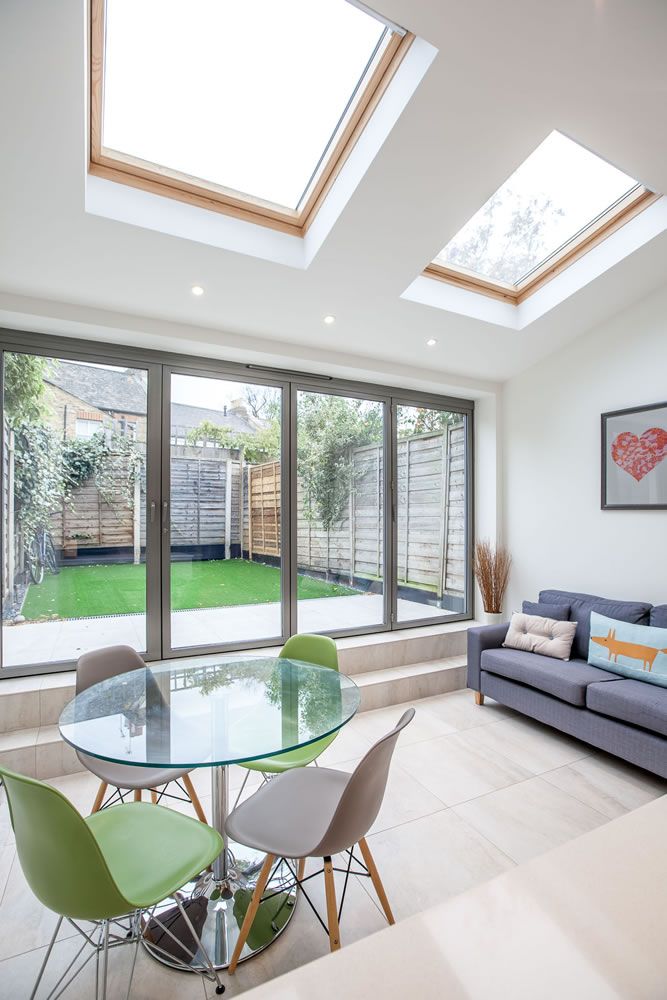
We love the idea of painting structural beams in a color that contrasts the walls and ceiling, and then linking this color to the rest of the space.
13. Zone areas in a small kitchen extension
(Image credit: Malcolm Menzies)
It's really important in the planning stages of your small kitchen extension to think about how you want to use the space. What 'areas' will go where. This will help you envision the extension but by creating these zones you can also make the space feel larger.
See how this quite small (still lovely) galley kitchen leads out into a wider, brighter dining space that's filled with natural light. The eye is natural drawn to that area which visually expands the space.
14. Create an open plan feel with kitchen island
(Image credit: Kasia Fiszer Future)
If the aim of adding a small kitchen extension is to give your space that open plan feel, a kitchen island is a must. The island is likely going to become the heart of the kitchen, and that basically means it's going to become the heart of your home. A place to cook and eat yes, but also a place to socialise, to work and relax too.
A place to cook and eat yes, but also a place to socialise, to work and relax too.
So think about it's positioning – you are going to want to be near enough to the main kitchen for it to have a practical use but also this the area you want to have the nicest views and the best natural light.
15. Leave a brick wall bare for an industrial edge
(Image credit: Philip Lauterbach)
Kitchen extensions usually mean you gain a few new walls, giving you the perfect opportunity to add a bare brick wall to your kitchen space. It's a classic look that's not going to date any time soon, plus is a really easy way to ensure there is plenty of warmth and texture in your space.
Just be sure to make your decision early on so you can pick a brick that's going to look lovely on the inside as well as the outside. We love the pale color and distressed look of this wall – it still feels contemporary, so matches the style of the space, but still brings in some character.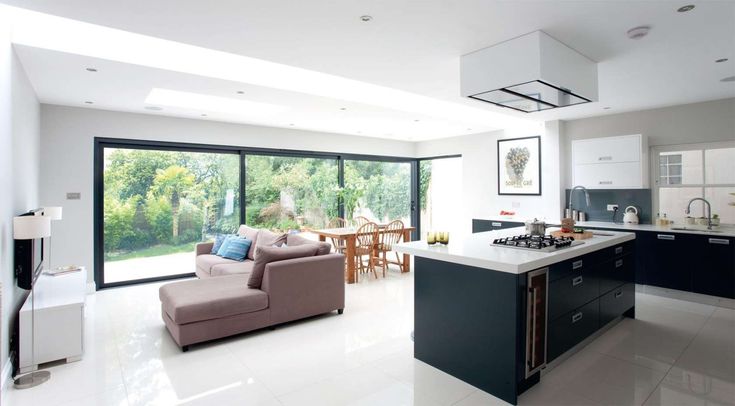
Is a small extension worth it?
Small house extension ideas can be intricate to plan, but they're often well worth it.
'The benefits to family life are huge.' says Robert Wood. 'Whilst we are currently spending so much time at home, a kitchen extension can function in many different ways. Having more family space for meals, working from home or home schooling make the extra space more worthwhile!'
Always take the advice of your architect, they will be able to tell you exactly what's going to work in your space and whether extending is worth it.
How much does a small kitchen extension cost?
'A small kitchen extension I.e. side return extension (I.5m x 4.5m) would on average be £45,000 ($63K,000) upwards. Prices always vary due to specifications such as windows, doors, flooring kitchen fitting etc.' continues Robert Wood.
Obviously, the cost of your project will totally depend on the size and style of extension you are going for. Plus whether or not you are having a totally kitchen remodel inside too, but if you want more a breakdown of costs, head to our single storey extension guide.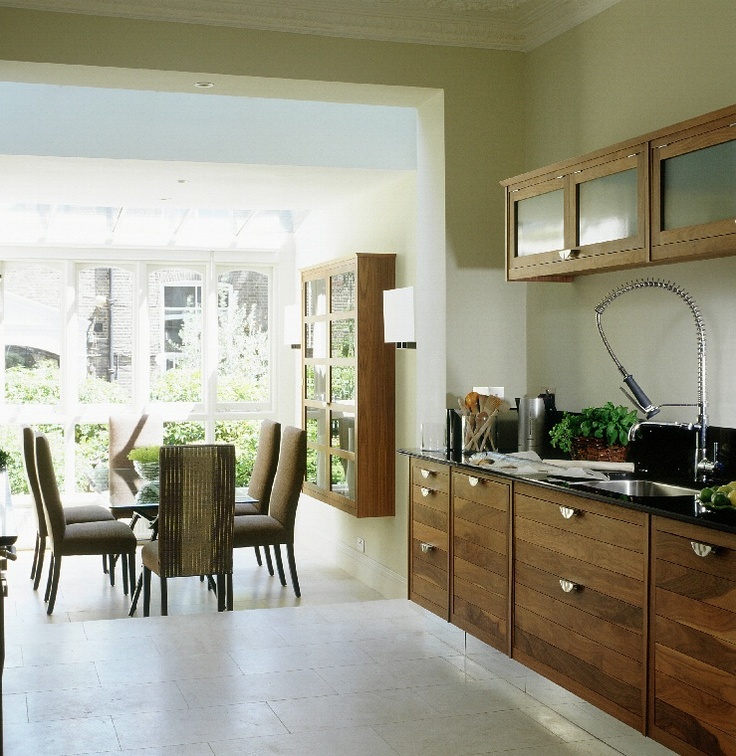
Hebe joined the Real Homes team in early 2018 as Staff Writer before moving to the Livingetc team in 2021 where she took on a role as Digital Editor. She loves boho and 70's style and is a big fan of Instagram as a source of interiors inspiration. When she isn't writing about interiors, she is renovating her own spaces – be it wallpapering a hallway, painting kitchen cupboards or converting a van.
Kitchen extension to the house from a pro with 13 years of experience. Click!
Kitchen extension to the house.
What would your kitchen look like?
Of course, attached to the house?
Like this
And like this
And like this.
Various.
It can be summer or winter.
May be on the 1st floor or 2.
May be adjacent to the house. may be somewhat distant from it.
There are many options, but you have exactly 1 chance to make the extension successful.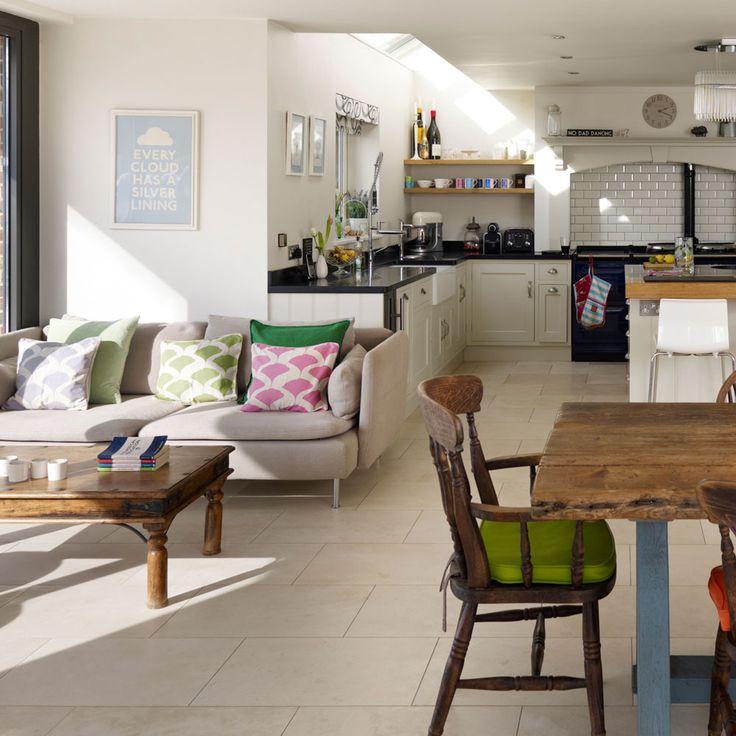
These are not shoes / for women - boots that you buy once a season. This is an extension for 20-30, or even 50 years.
The choice is serious, so you need to think it over well, consult, draw in full growth and size. See what happens and then fix it if you don't like it.
You can even start with such a plan.
Yes, a process that lasts a month, or even several years. Many have an idea for years and then implement it. Or not.
To avoid mistakes, it is better to contact a specialist who knows a lot about extensions. It is in them. Building a house is easier. Renovating an apartment is generally easy. But the extension of the kitchen to the house is a completely different story.
Let's start it!
Tatyana Fedorovna lived and she wanted a spacious kitchen-living room in her house. Let it be an ordinary house 7x8 meters in 1.5 or 2 floors. Internet searches have borne fruit. She found several firms and teams. I called and made an appointment with some of them.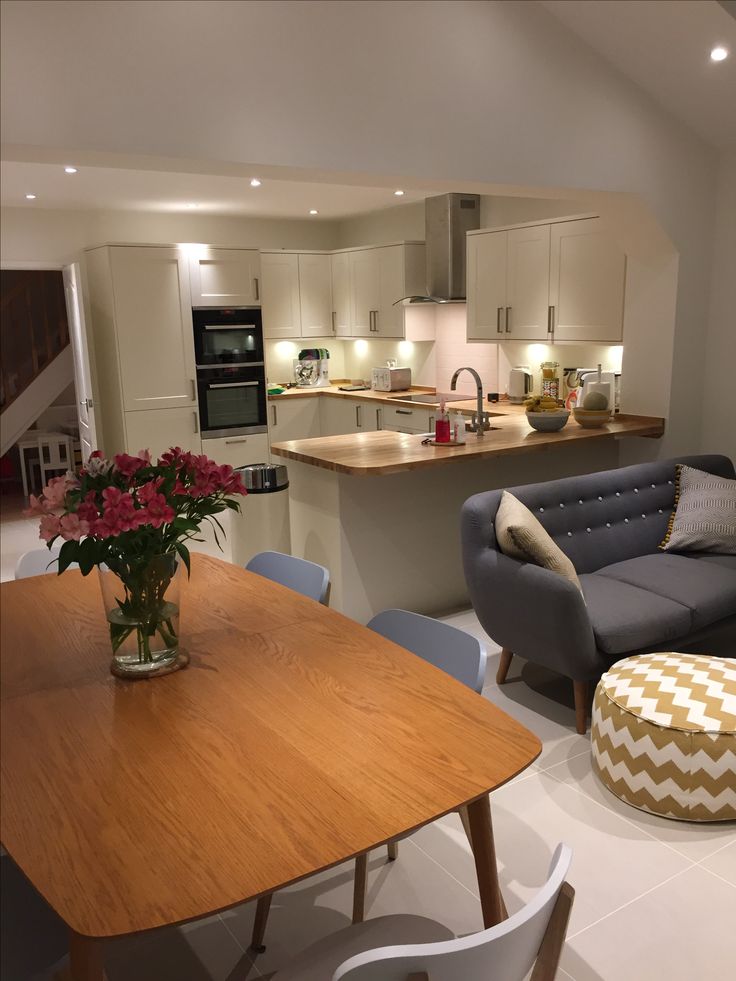
Someone has arrived, someone has not. And someone said that he would come only to conclude a contract for the project. What's the point of just dating. Here the next character of our story appears - Anton (yes, it's me).
Tatyana Fedorovna thought a little, looked at the work on the site and decided on the project. Do it anyway. Moreover, if the price does not suit you, then you can send it to other companies for miscalculations and find out the price there.
Yes, that's a good idea.
The meeting took about 2.5 hours. At this time, Anton took all the measurements, filled out a questionnaire of more than 50 questions, took photos and videos at home.
Plans and facades are also sketched.
Liked it. The impression is positive. After a quick 20-30 minute meeting with other people, this person made an impression. If not a professional, then at least a person who understands something. It is a fact.
Then we made a project,
By the way, visualization.
Exactly what we wanted!
Also made a few edits along the way: changed the stairs, the entrance to the existing house and much more. 2 weeks flew by unnoticed, and then there was the main work, which no one canceled.
Adding a kitchen to the house - is not a quick process and the project must be drawn up correctly: all heights, all plans and stairs must be thoroughly thought out.
It's one thing to draw.
And another thing is to build what has been drawn and bring it to life.
And here, a common problem for designers and architects who are out of touch with construction is that the idea is unrealizable in practice.
That is, they drew it, but it is not possible to do this. Or due to the lack of data materials. Or because of unaccounted for loads, or maybe there are simply no professionals to implement these works.
Therefore, the advice - this is already from Anton - do the project in an embrace with the builder.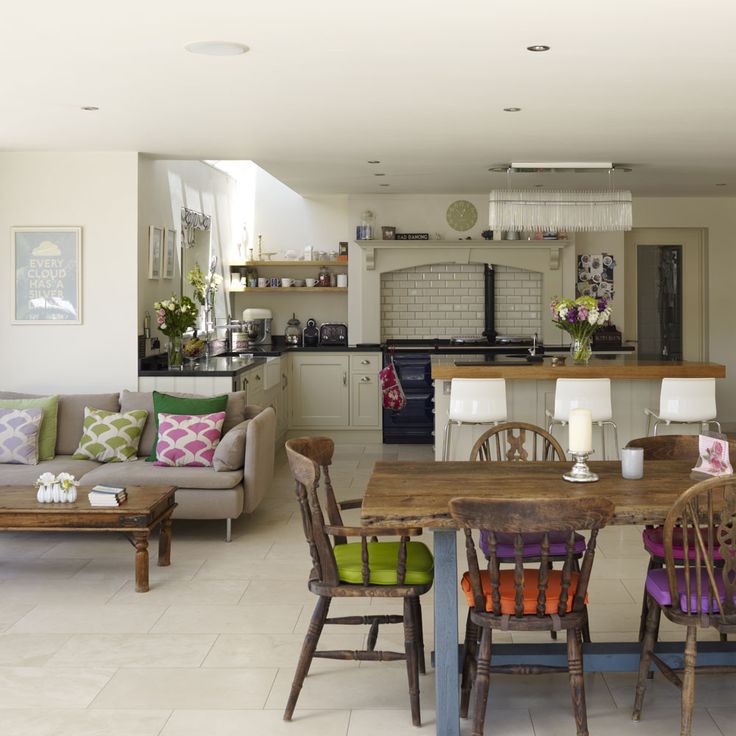 Because many people first look for an architect, thinking that he knows better how and what. He's also an architect. And they remember the builders after, when everything is ready. And it turns out that the overlaps do not correspond to the load. The roof slope should be more than 13 degrees for metal tiles, window openings are too large for such a roof area - they cannot be strengthened in accordance with SNiP, and so on and so forth.
Because many people first look for an architect, thinking that he knows better how and what. He's also an architect. And they remember the builders after, when everything is ready. And it turns out that the overlaps do not correspond to the load. The roof slope should be more than 13 degrees for metal tiles, window openings are too large for such a roof area - they cannot be strengthened in accordance with SNiP, and so on and so forth.
The picture is beautiful, but the execution is impossible.
And it turns out that the project needs to be redone. A rare architect will do it for free. The answer will be simple: you wanted, I drew. Alterations cost some money and will be right in their own way. He won't build it. Its task is a beautiful picture that you like.
That's the point of such a waste of time and money when you can immediately apply to a company that already has its own architects. Who sit in 1 office (on the edge in the neighboring ones) with technical supervision, foreman or chief engineer.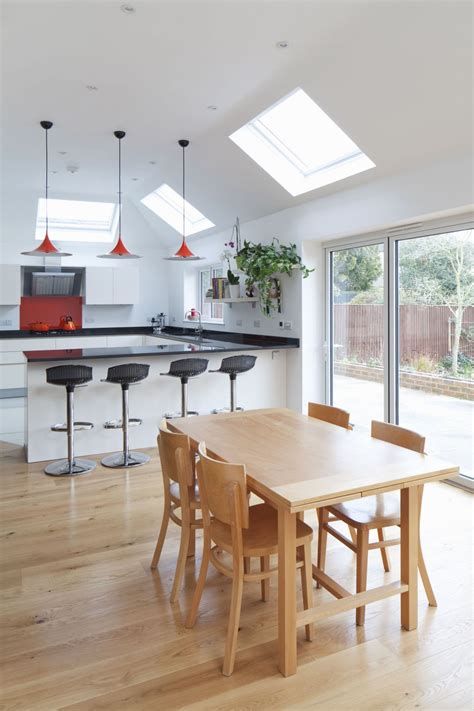 Whatever you call this position, this is a person who will be responsible specifically for the process of building your kitchen extensions to house .
Whatever you call this position, this is a person who will be responsible specifically for the process of building your kitchen extensions to house .
I hope I explained clearly.
And now some beautiful pictures, how you can make it beautiful.
And it really can be built.
I wish you the same!
Do not forget that the extension can be either 1 floor or 2 floors. And you can also bury the cellar))
That's all, contact the professionals and may the force be with you))
You can start with the engineer's visit to the facility and the project.
Anton Shchelkov, Construction+.
Houzz Britain: Annex to the house - with kitchen and reading area
Reading nook next to the panoramic window, high glass doors to the garden and a spacious kitchen with a living room
Campbell Cadey
this house. They needed to expand the kitchen, turning the kitchen-living room space into a place where the whole family gathers.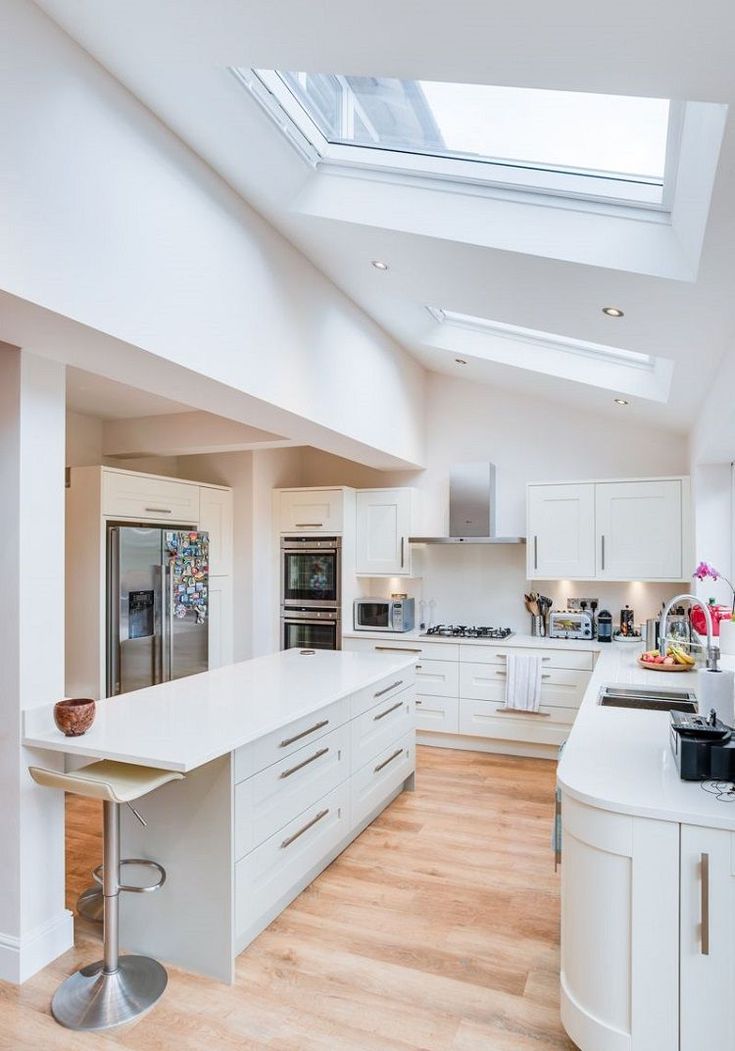
About the project
Location: Victorian house, London, UK
Size: kitchen combined with living room 56.5 sqm
Who lives here: lawyer family with two children
Project architect: Ruth Campbell, Campbell Cadey
9000 Photo : Richard Chivers Architectural Photography
Campbell Cadey
The new addition opens onto a backyard that opens onto a protected forest. And the owners wanted to open the kitchen part to the side of nature to the maximum. Architect Ruth Campbell recalls: “We didn't want to create one big amorphous space on the first floor. It was necessary to make an open layout, but with very clear zones.
Campbell Cadey
Kitchen extension sketch
Ruth decided not to make the kitchen extension the full width of the house: "The building is already quite wide, so it would have made the size of the house too bulky relative to the lot.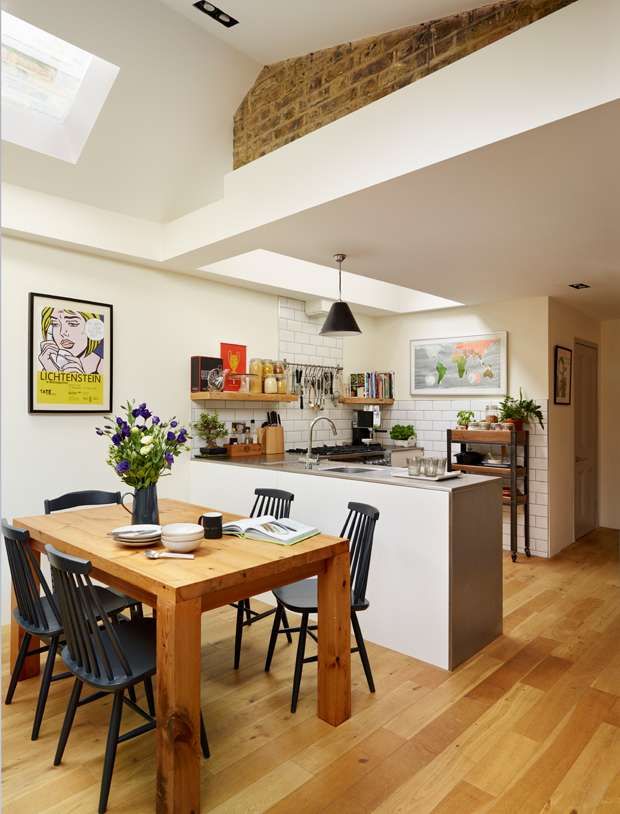 "
"
Campbell Cadey
House plan before renovation
After buying the house, the owners realized that the kitchen was too small. And the only solution, in their opinion, was an extension to the house, which expanded the kitchen part.
Campbell Cadey
Ground floor plan with extension
The architect reconfigured the ground floor to create a large family space. It has a good sized kitchen that opens on one side towards the living room and on the other side to the wooded area behind it.
Campbell Cadey
The extension was planned to match the style and materials of the rest of the house. It was built from reclaimed brick, similar in color to the old building. Some of the new walls were plastered to match the building's windows.
Campbell Cadey
In the white block with a panoramic window, they made benches for reading inside and outside the house.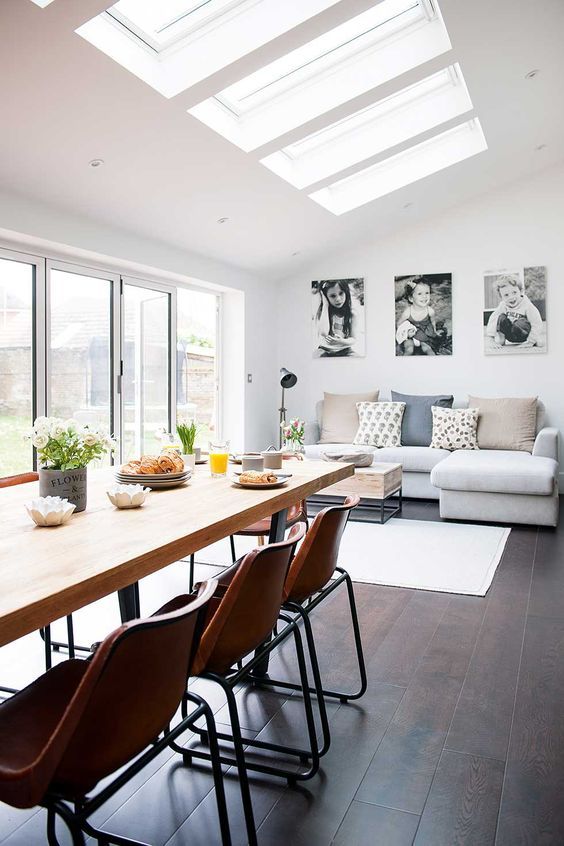 The cantilever at the top of the extension is made in order to create a shadow over the resting place.
The cantilever at the top of the extension is made in order to create a shadow over the resting place.
From the side of the street, a fire bowl was placed in front of the bench, next to which you can arrange family gatherings.
Campbell Cadey
The roof of the kitchen part was made transparent. From this angle, you can see that the site goes towards the forest.
Campbell Cady
The annex also has a side exit with a blind door (to the left of the window with a seat).
Campbell Cadey
The architect added concealed recesses above the doors and windows that could accommodate built-in blinds if desired: “If the owners find it too hot in the annex, they can install blinds later without disturbing the lines.”
Campbell Cadey
The window seat is deep enough to sit down to read or have a morning cup of tea.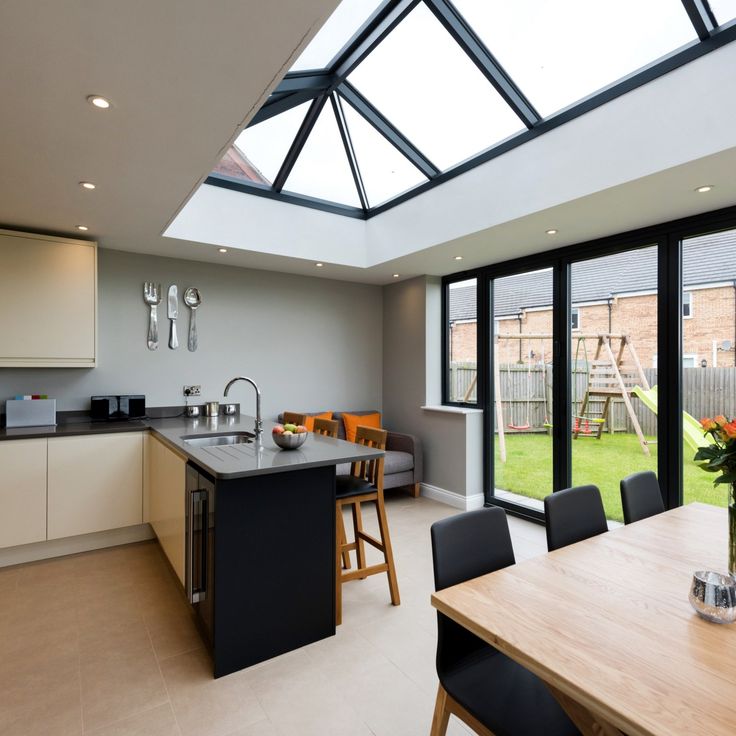
Campbell Cadey
“Many people puzzle over how to hang a chandelier under a glass roof. Here we did not invent new ways and simply hung the ceiling on a swivel bracket, it is attached to the wall, ”says Ruth.
Campbell Cadey
Dining room and kitchen view
Campbell Cadey
IKEA sofa; armchair Eames RAR
Lots of light in the living area thanks to floor-to-ceiling sliding doors. There is a wood-burning fireplace and a large corner sofa.
Campbell Cadey
Kitchen cabinets painted Mole's Breath, Farrow & Ball; Neff ovens
The kitchen frames were bought from IKEA, the fronts were sewn from Naked, and Carrara marble was used for the countertops. Everything a family needs was planned and placed in the kitchen: a full-sized refrigerator, a freezer, a pantry, a dishwasher, two built-in ovens.